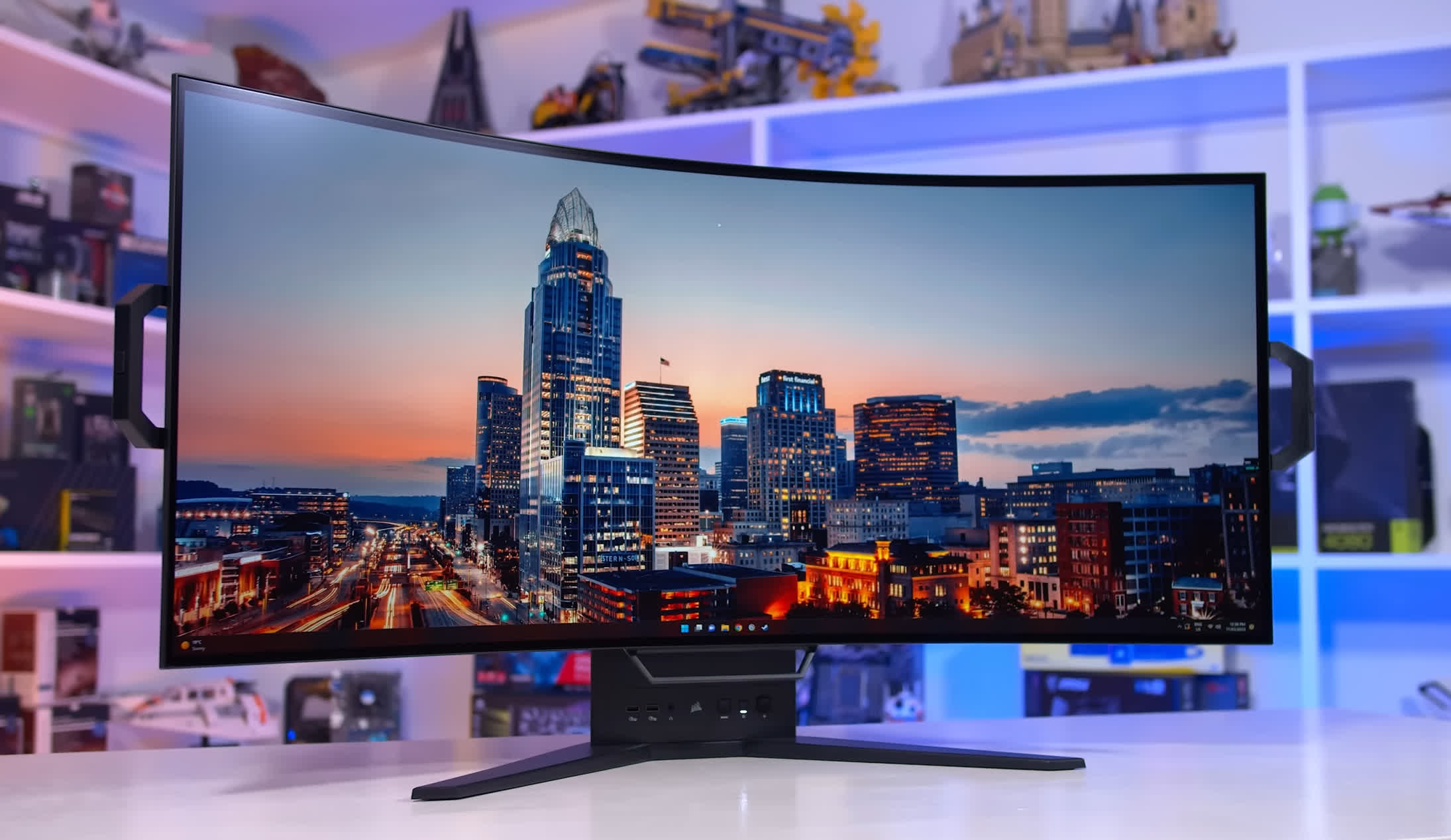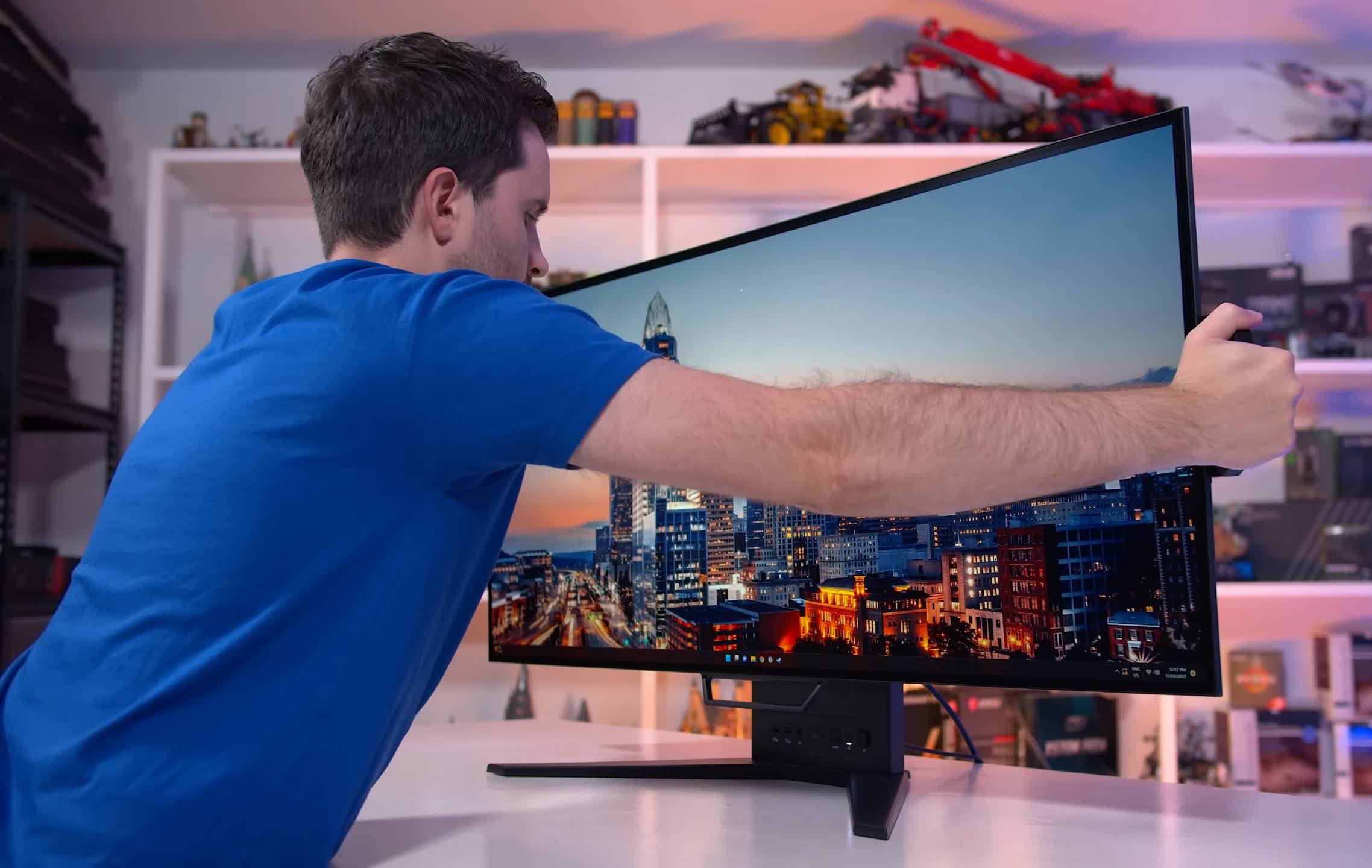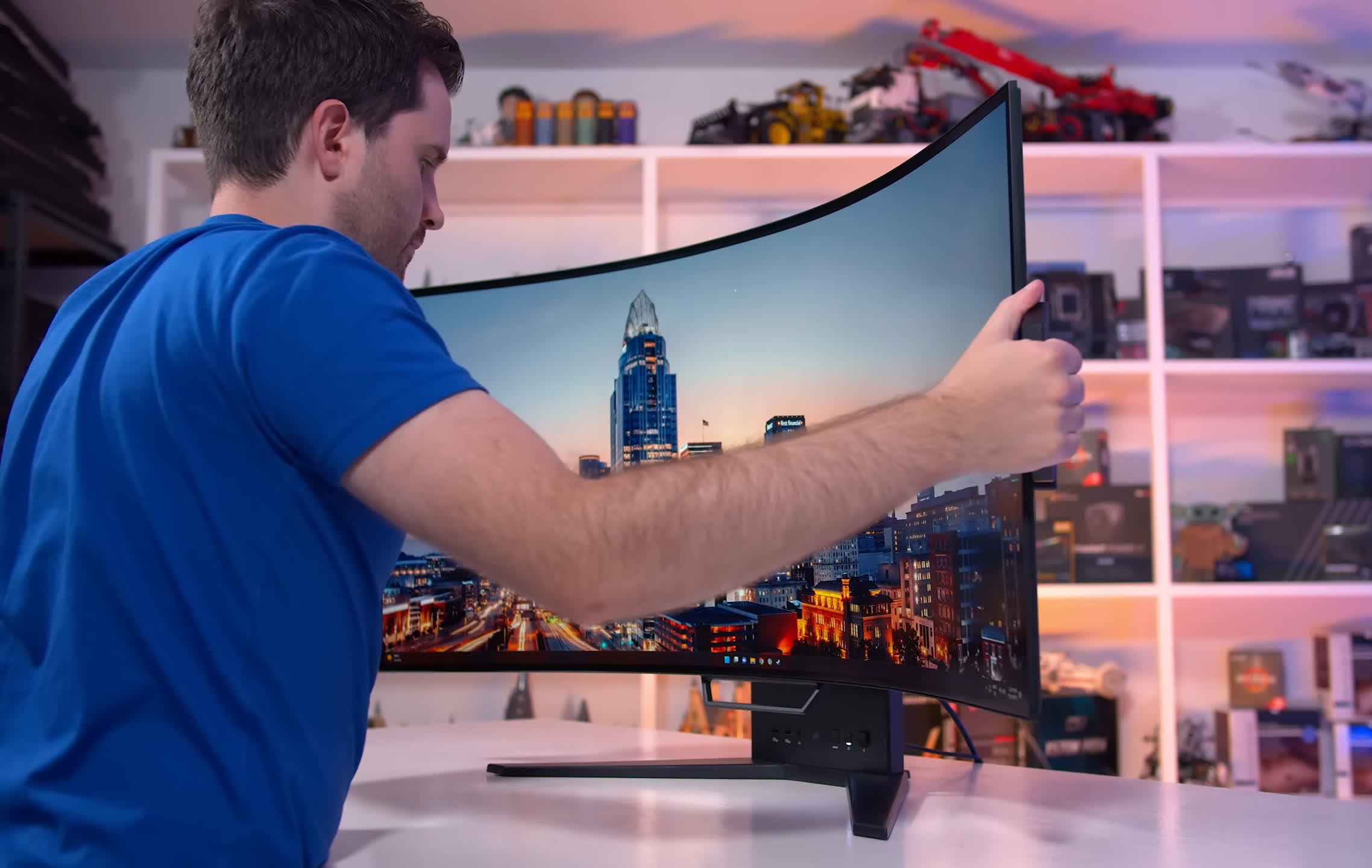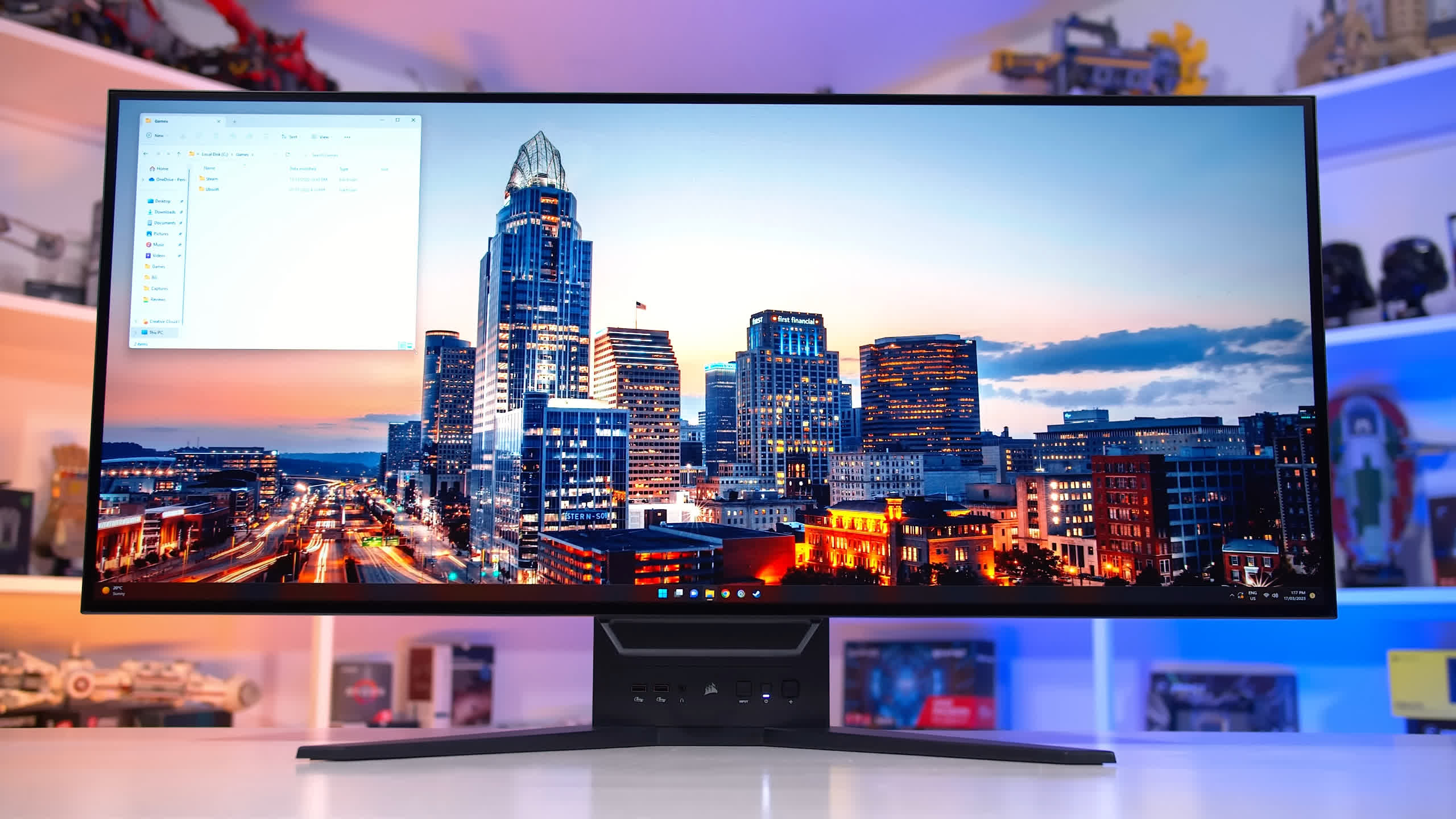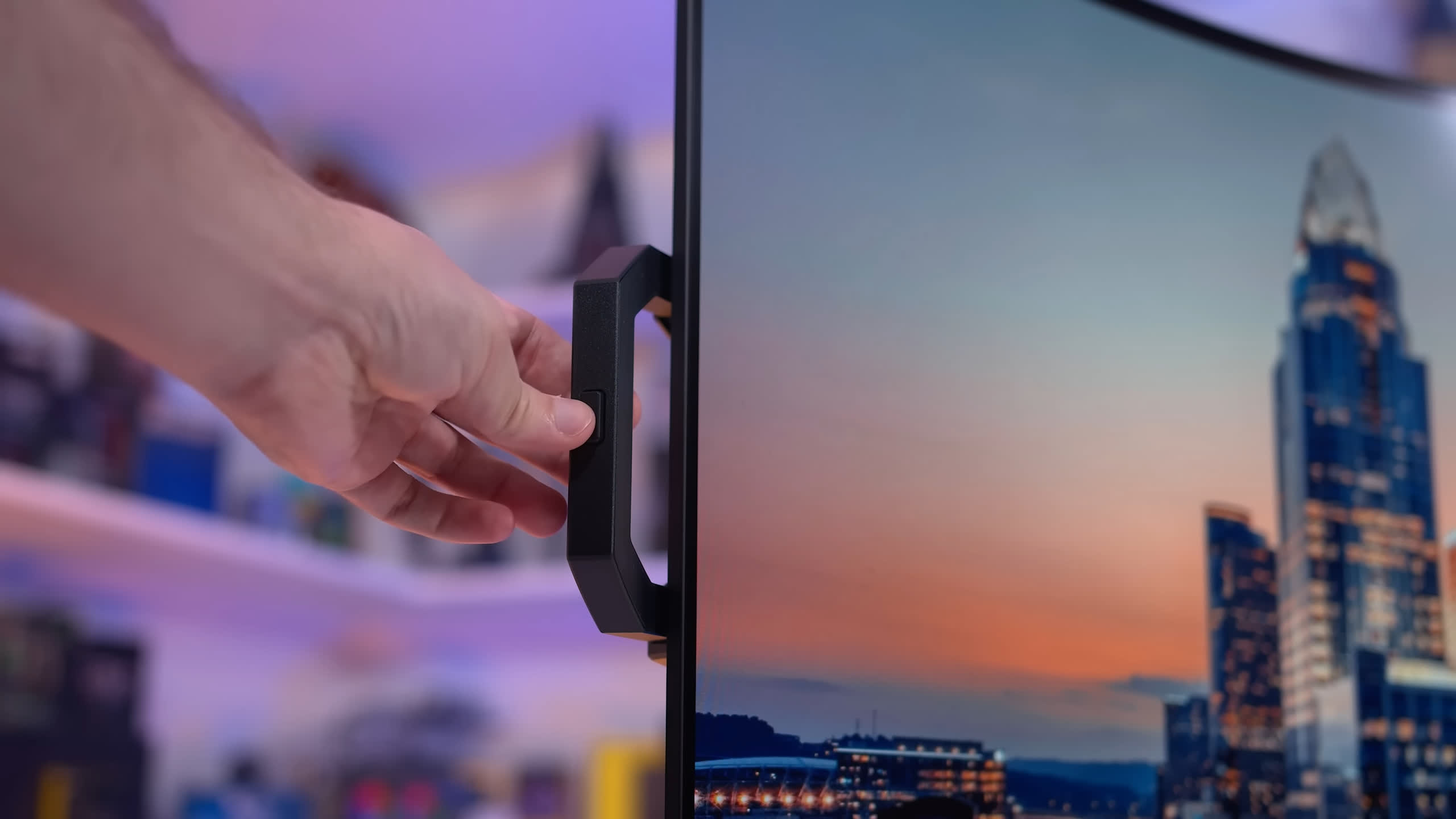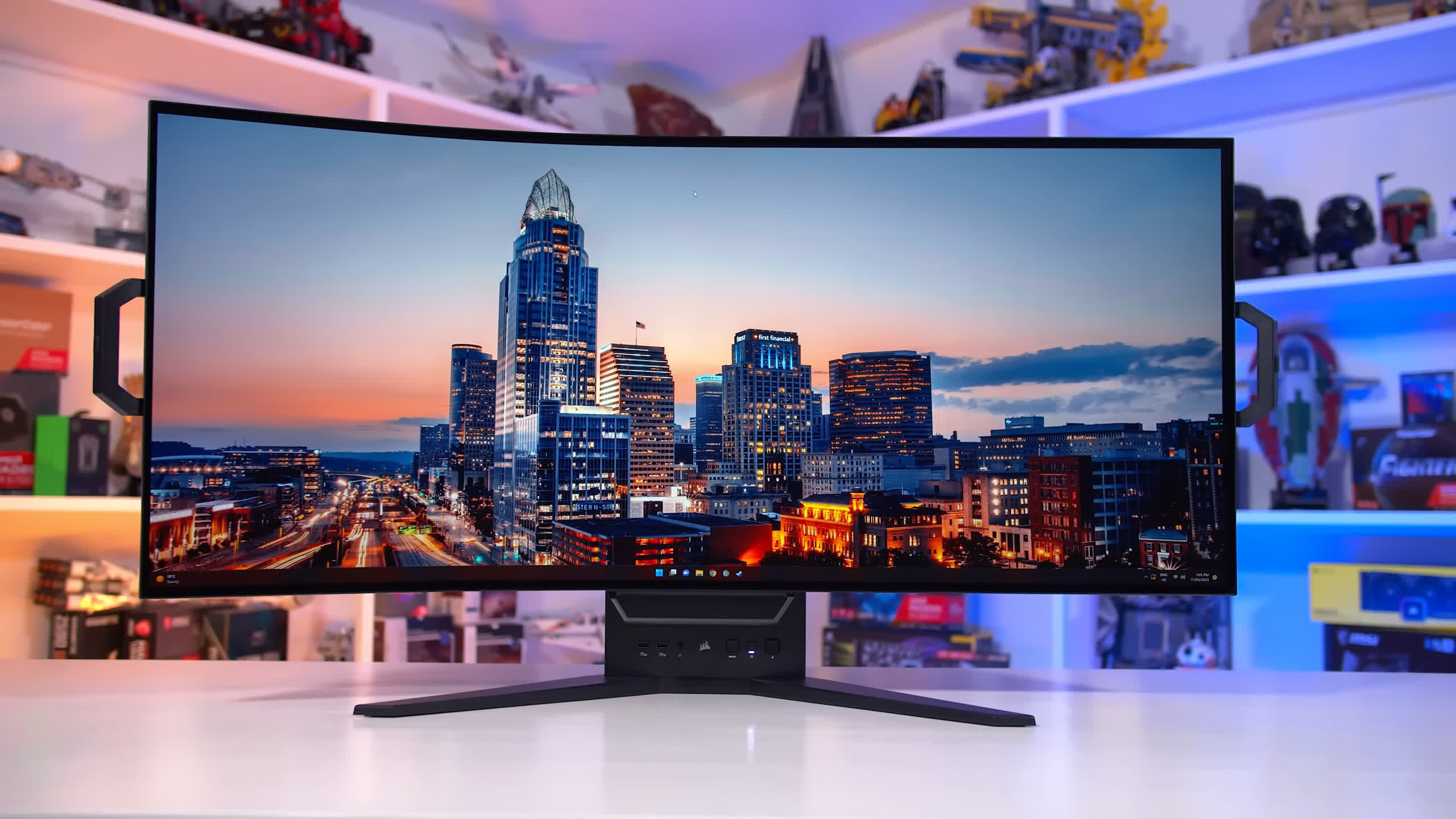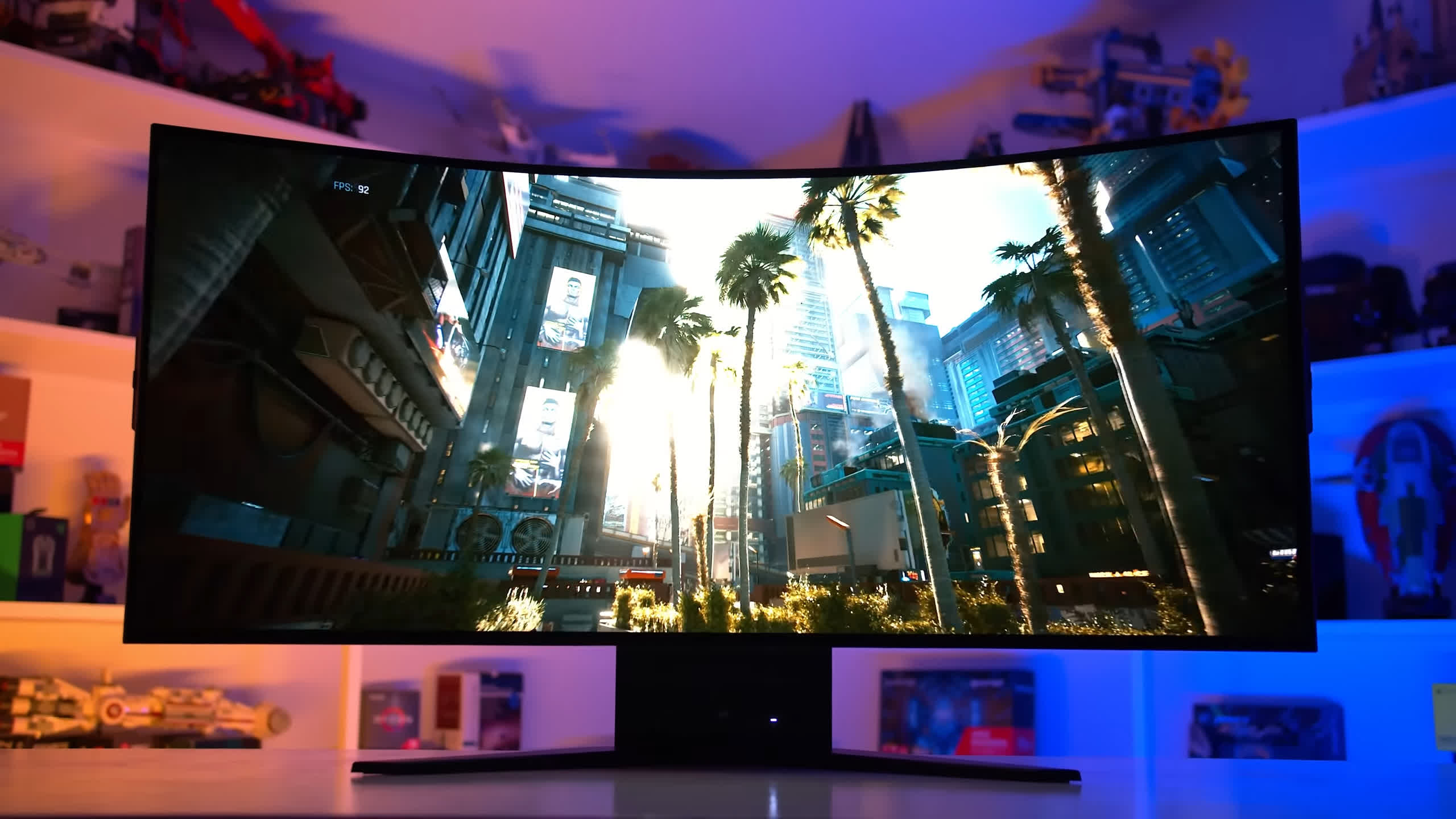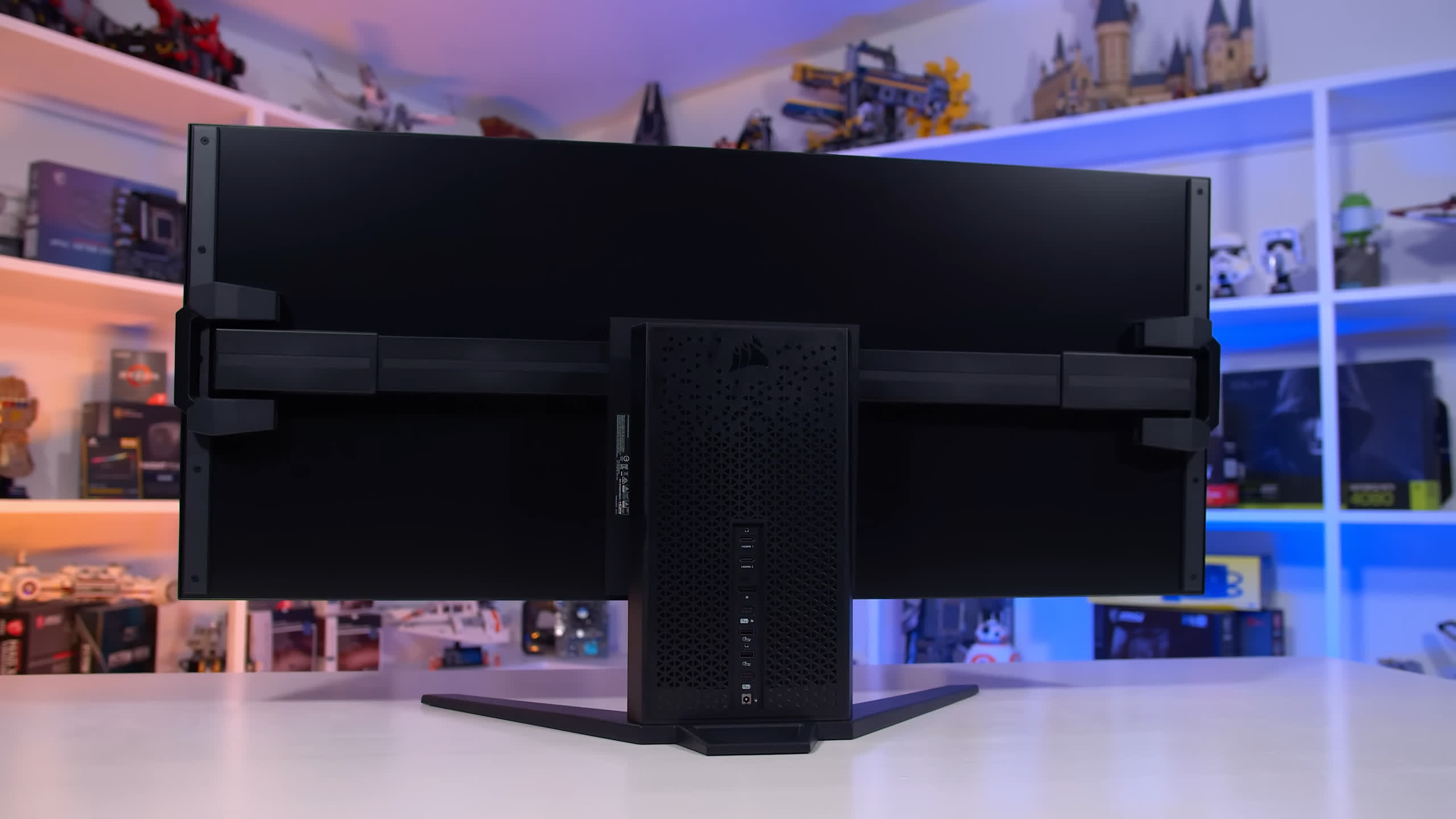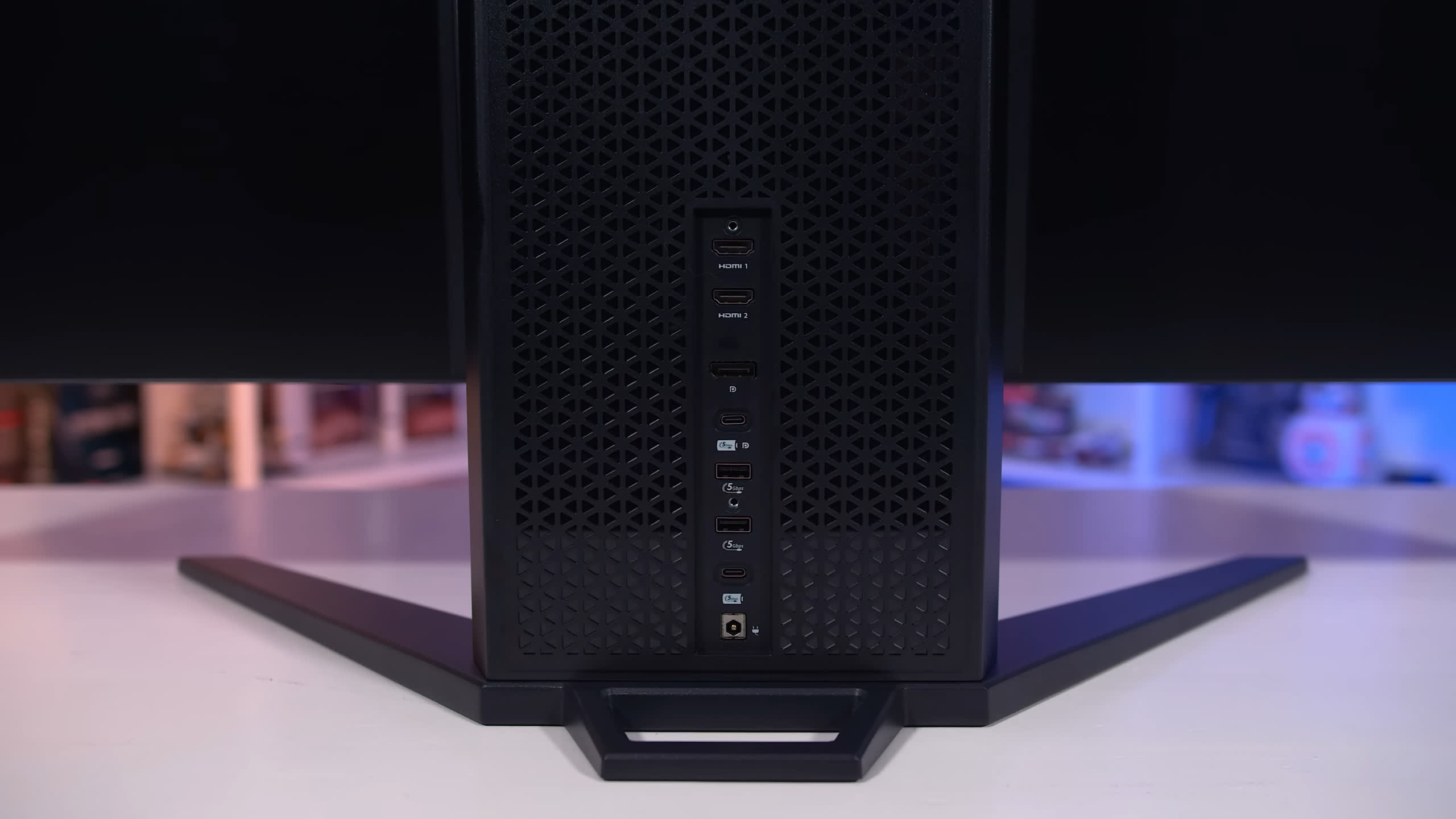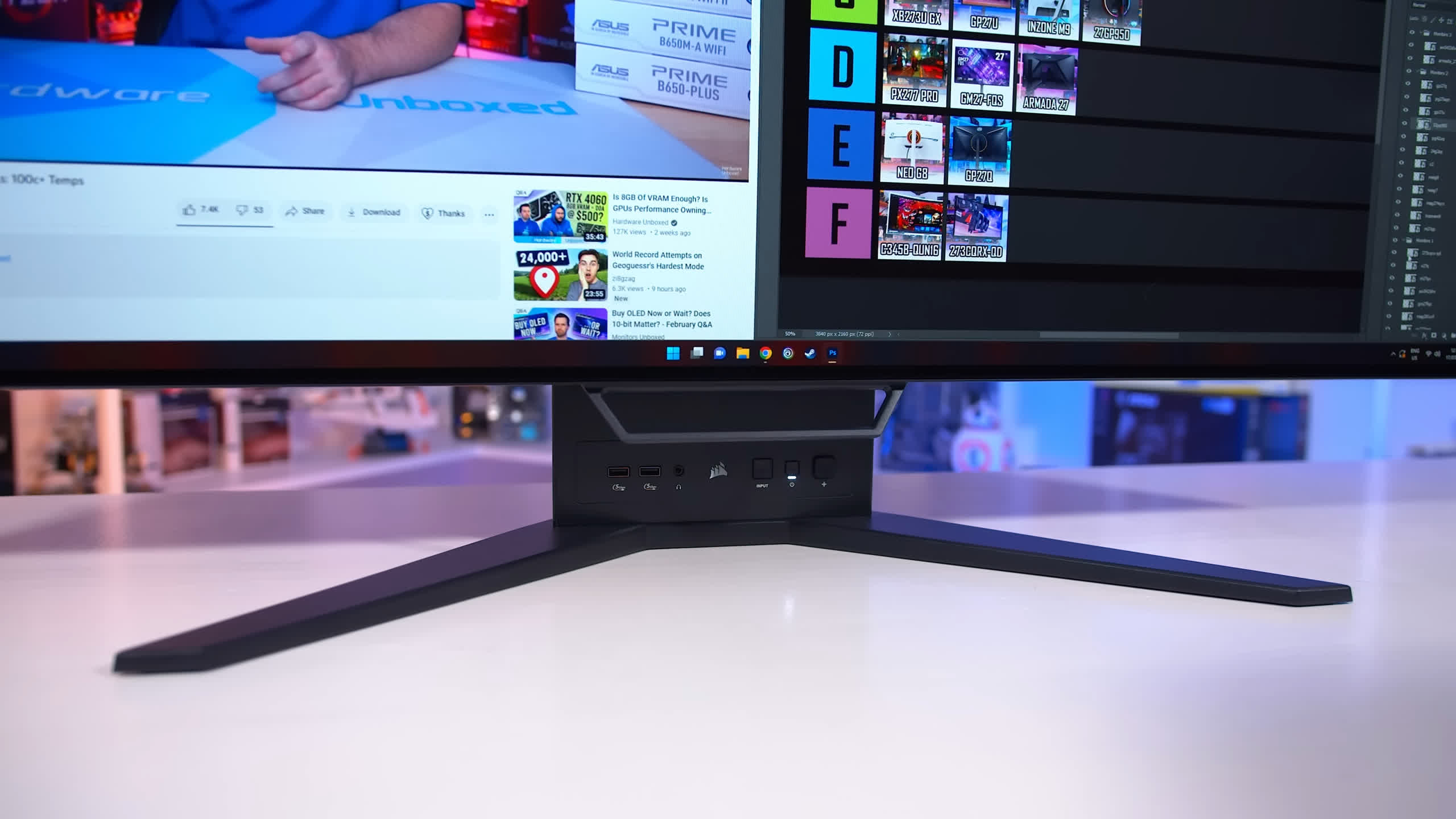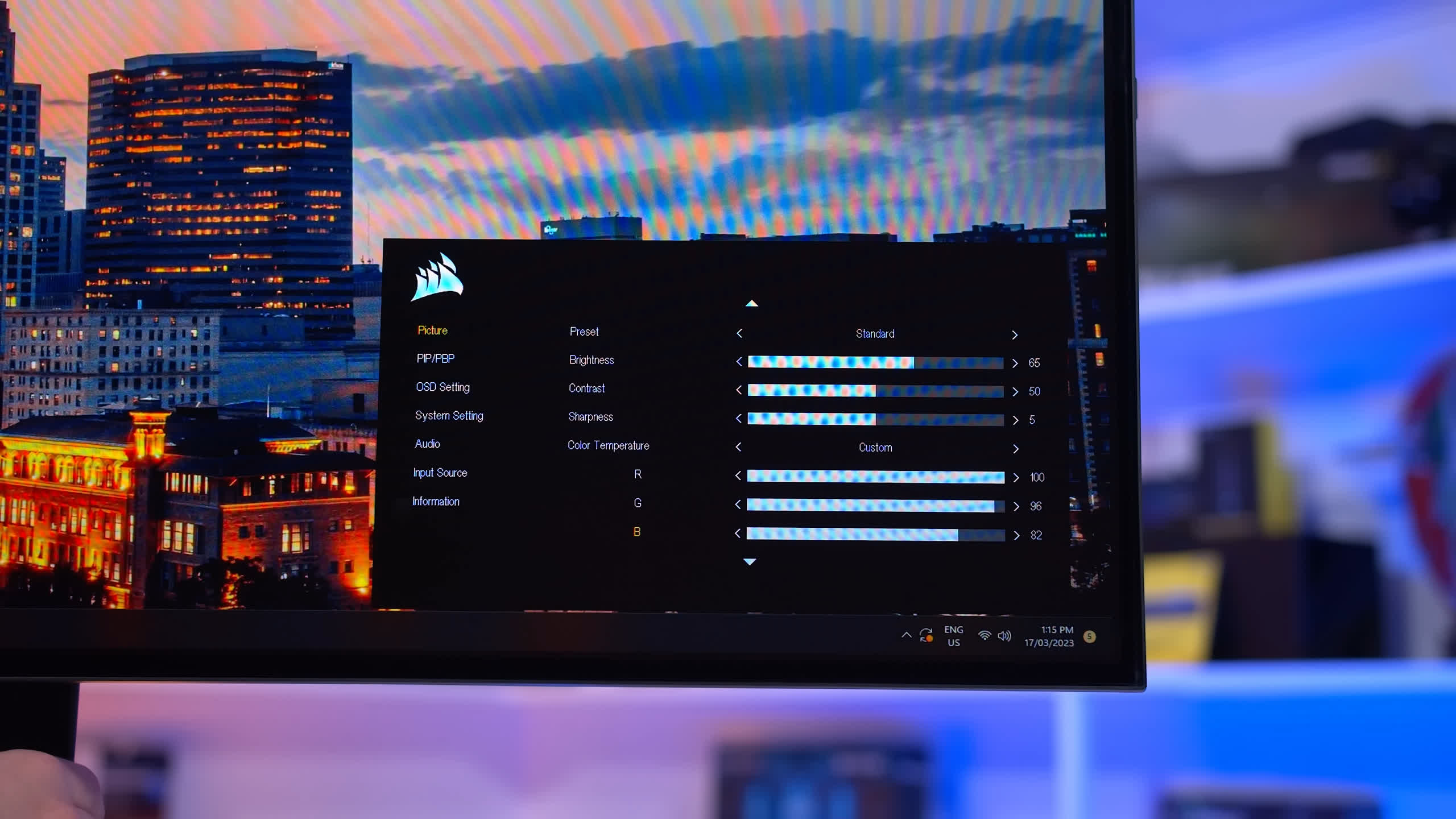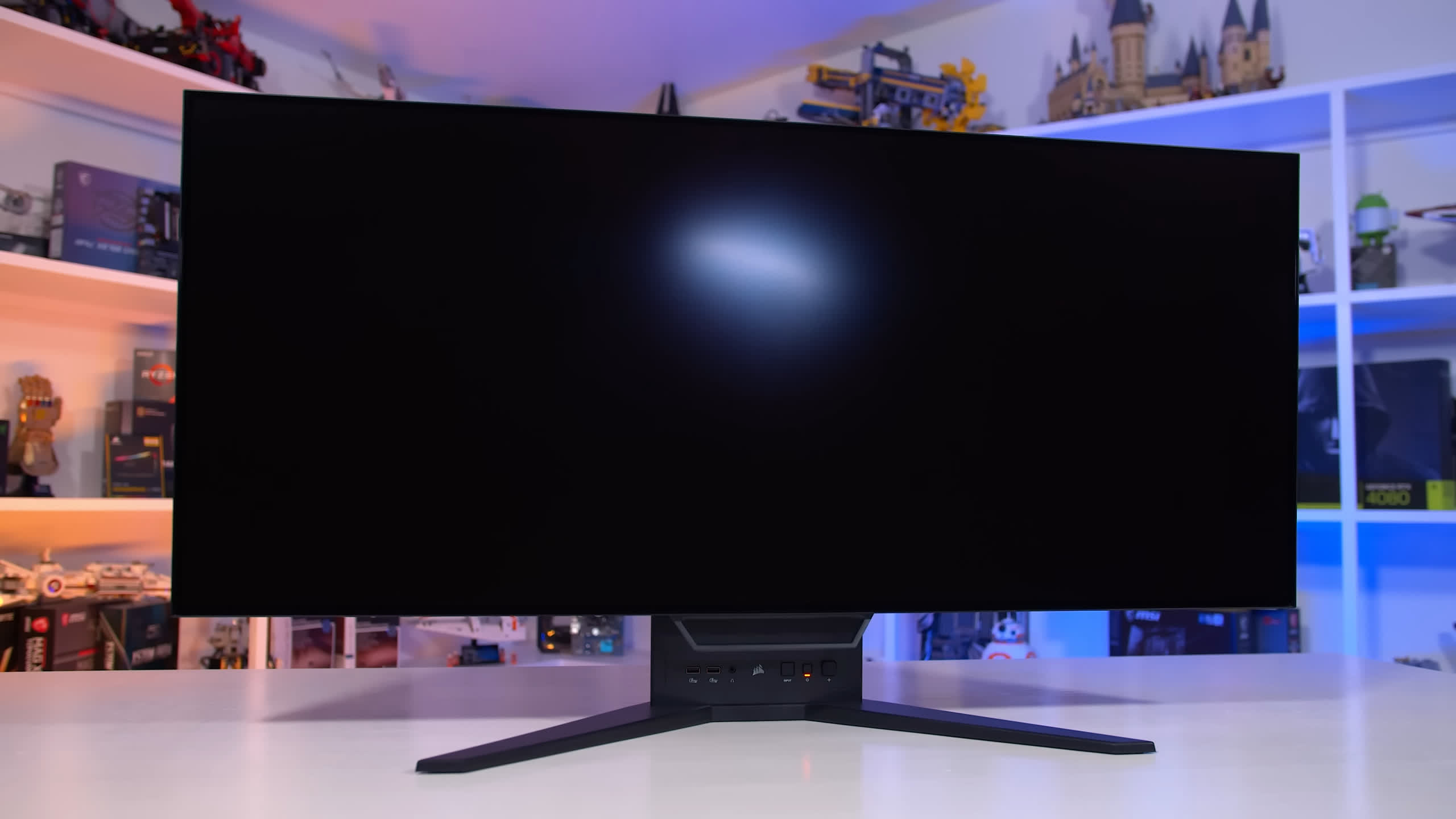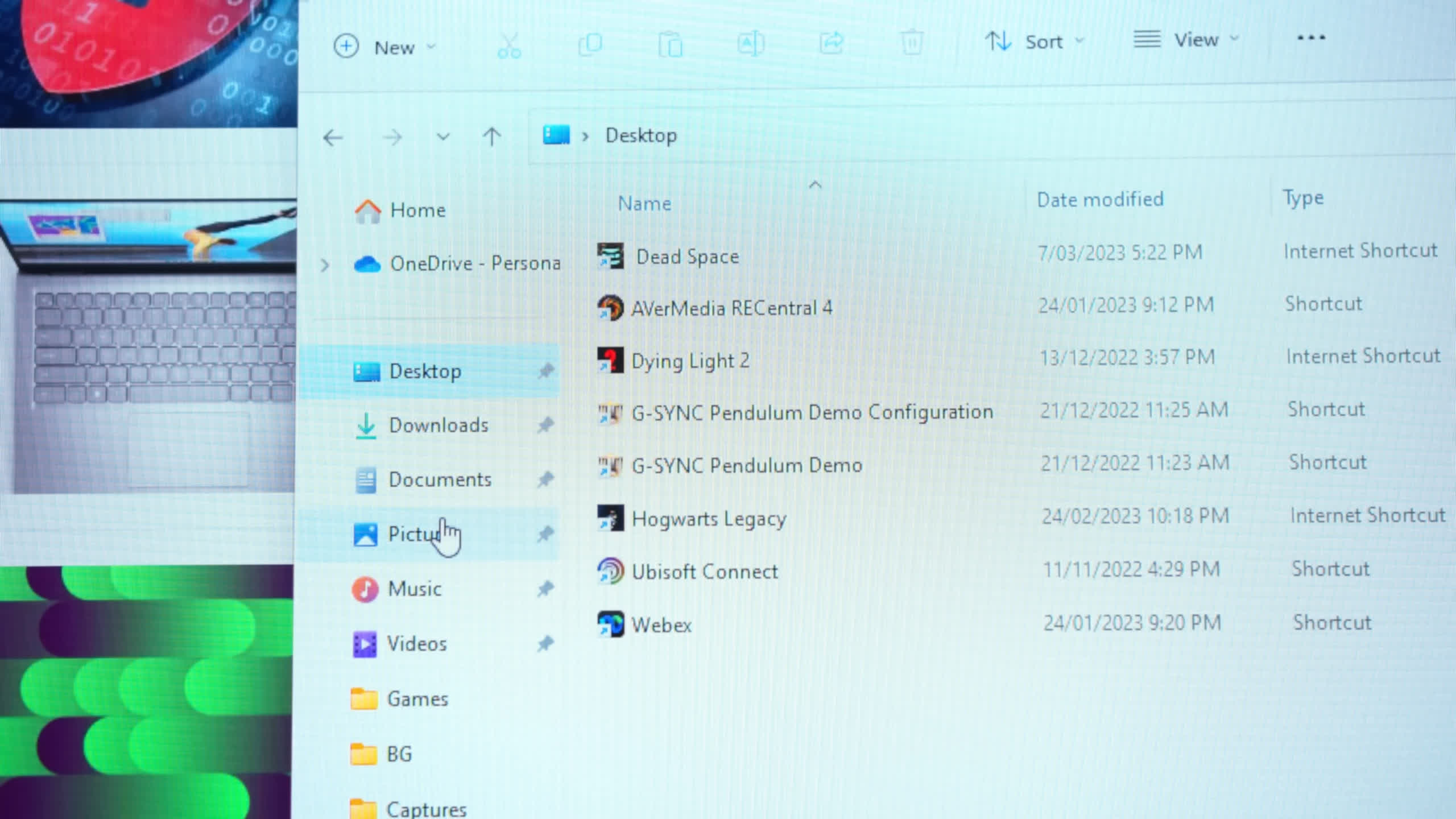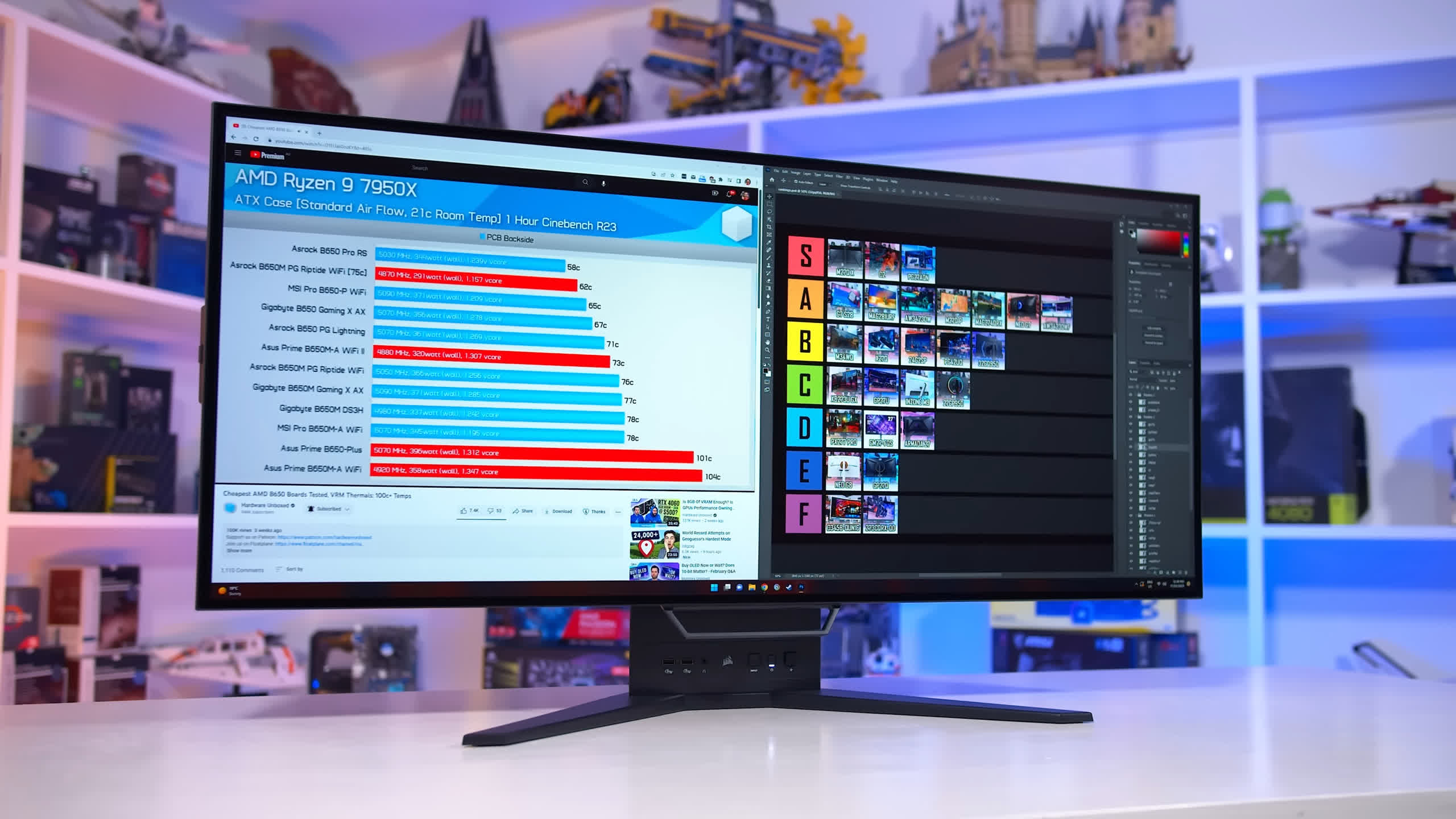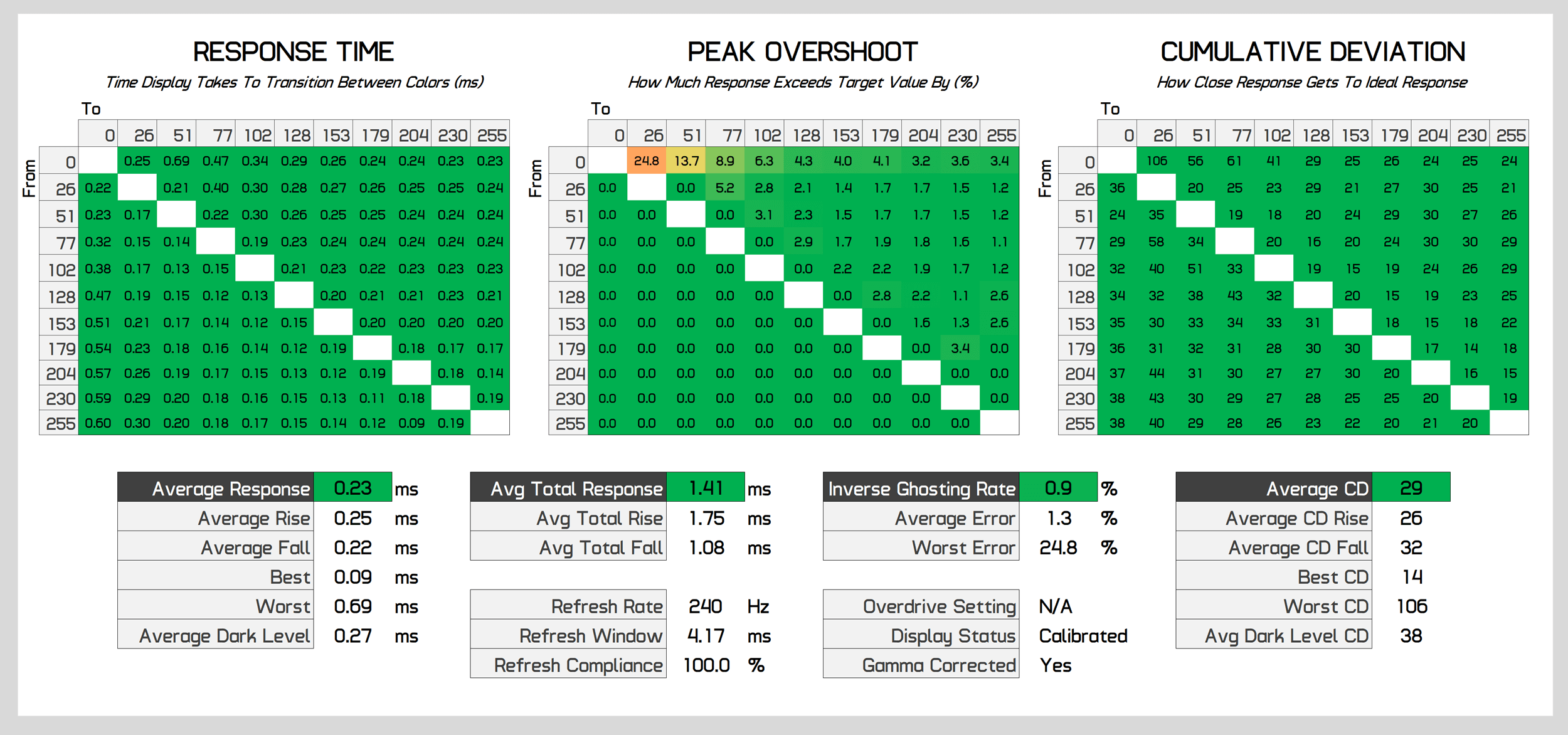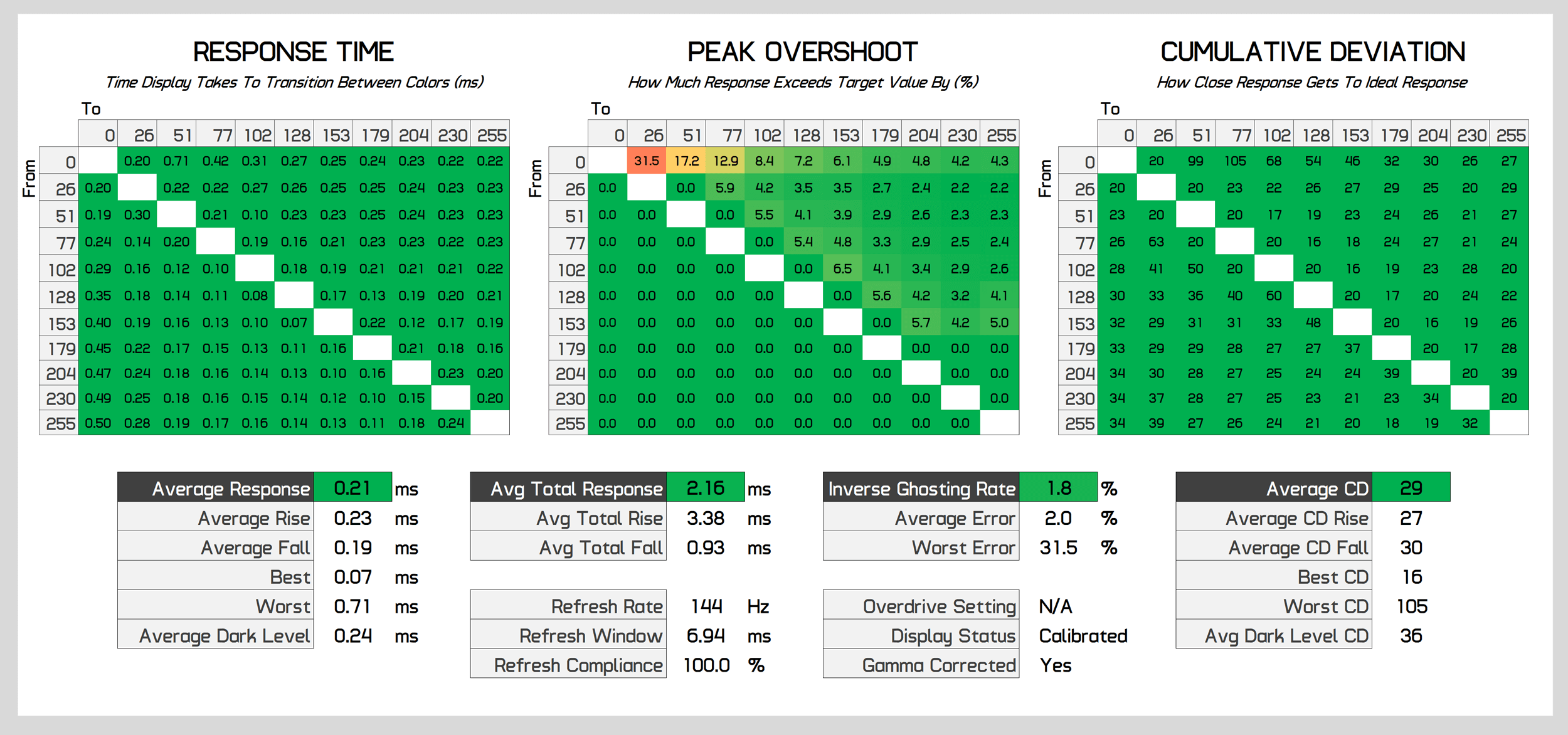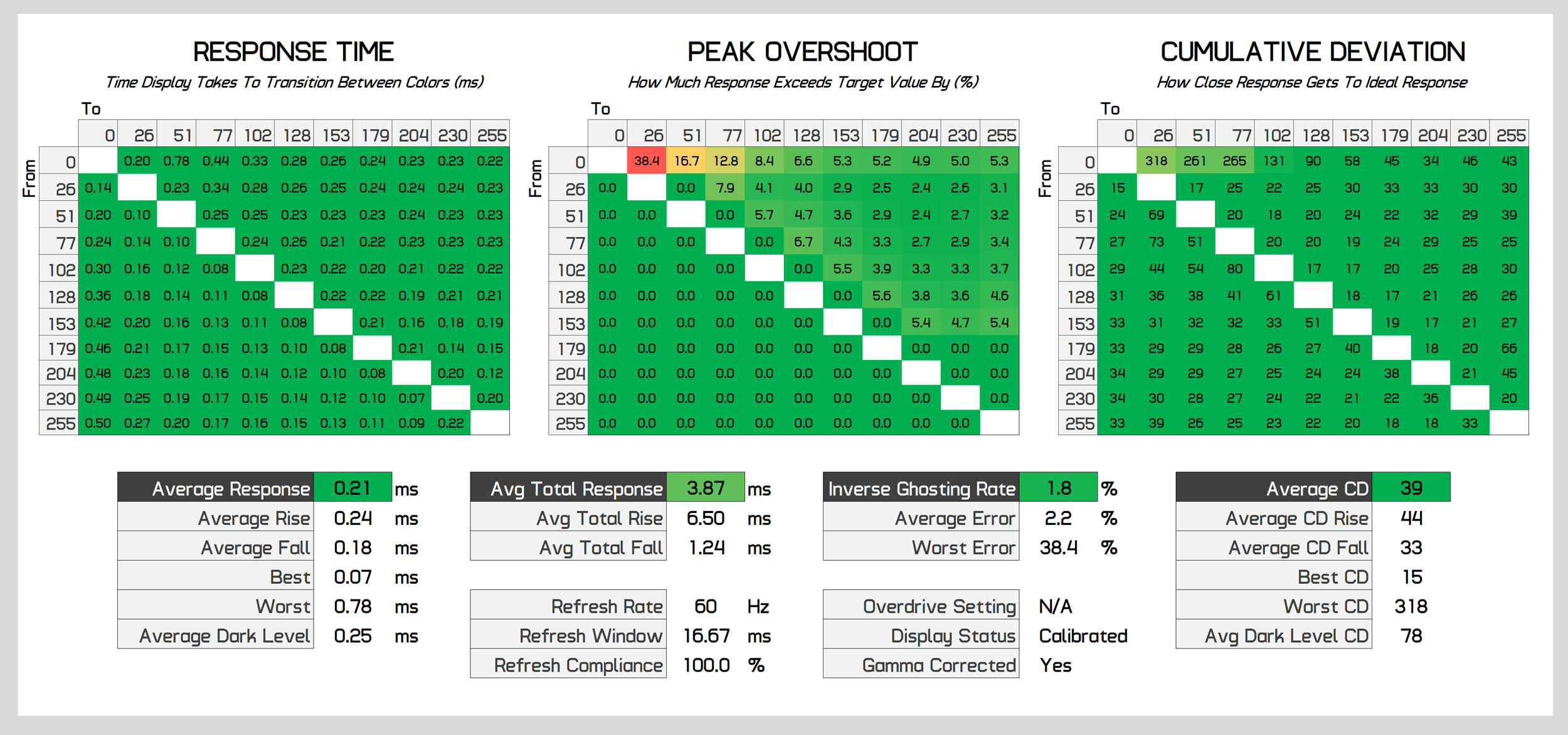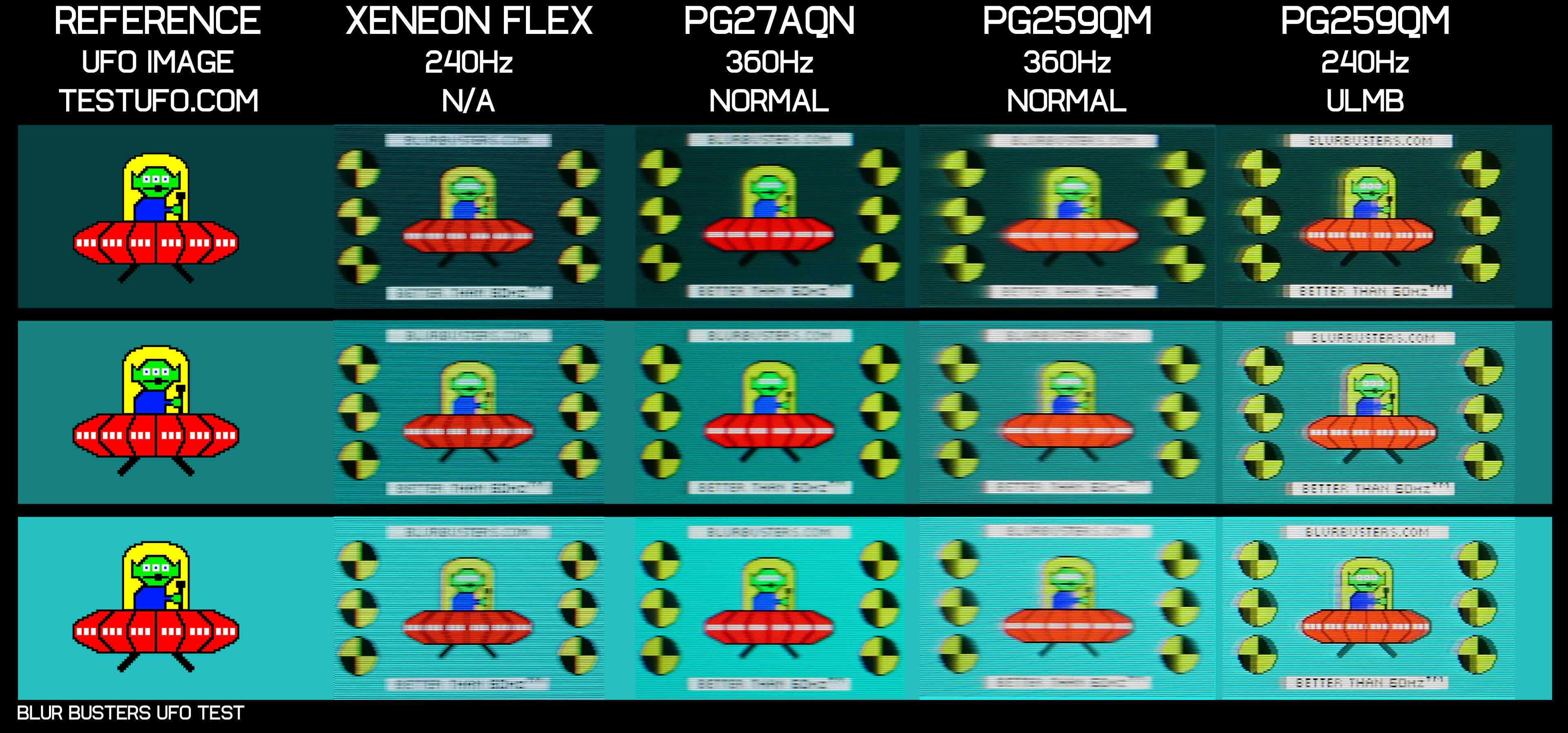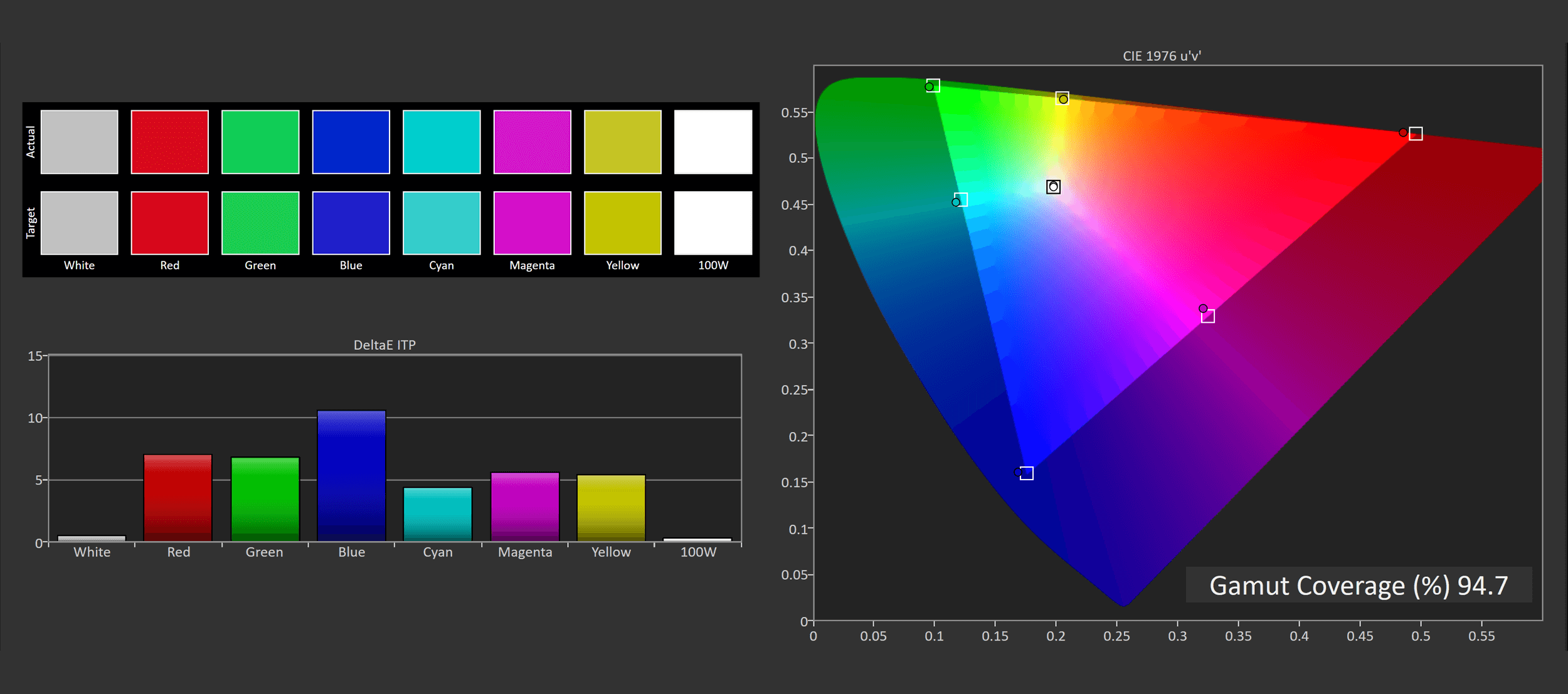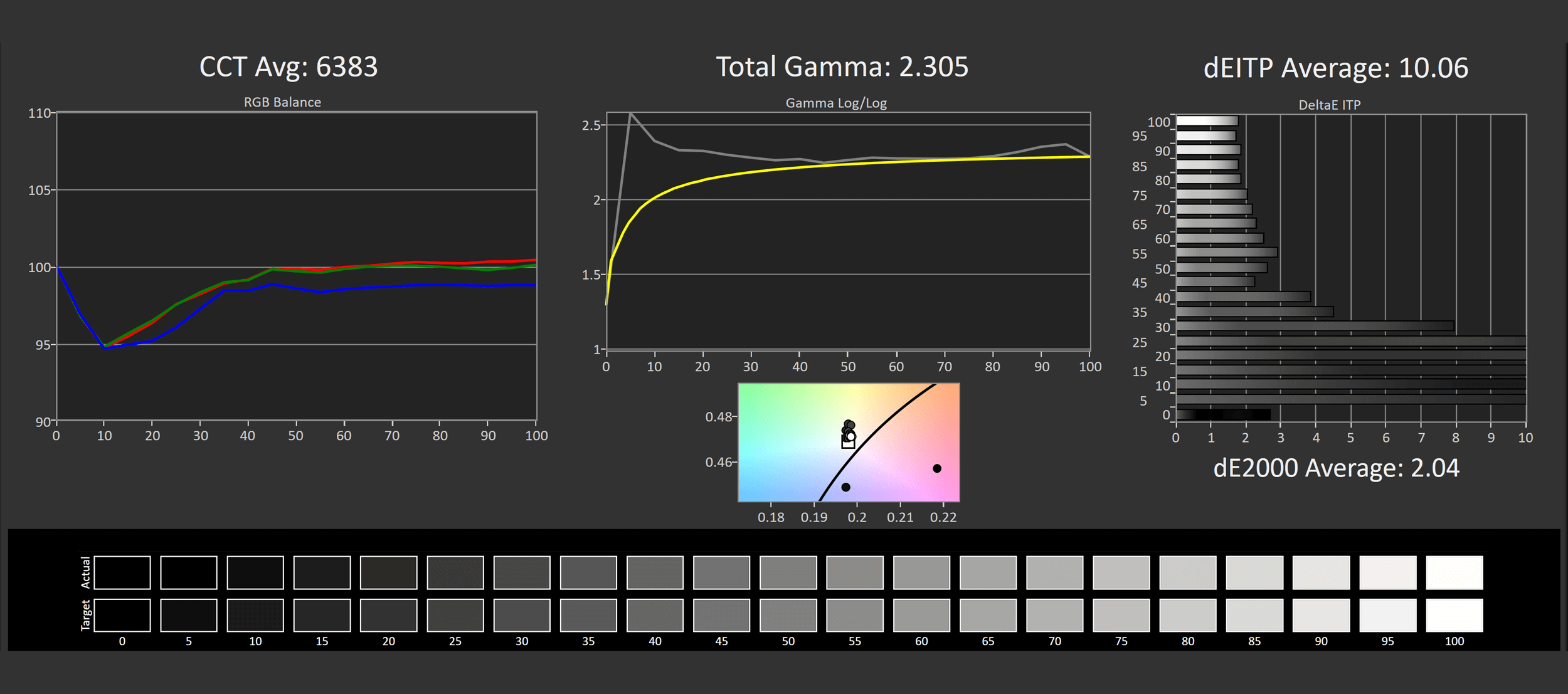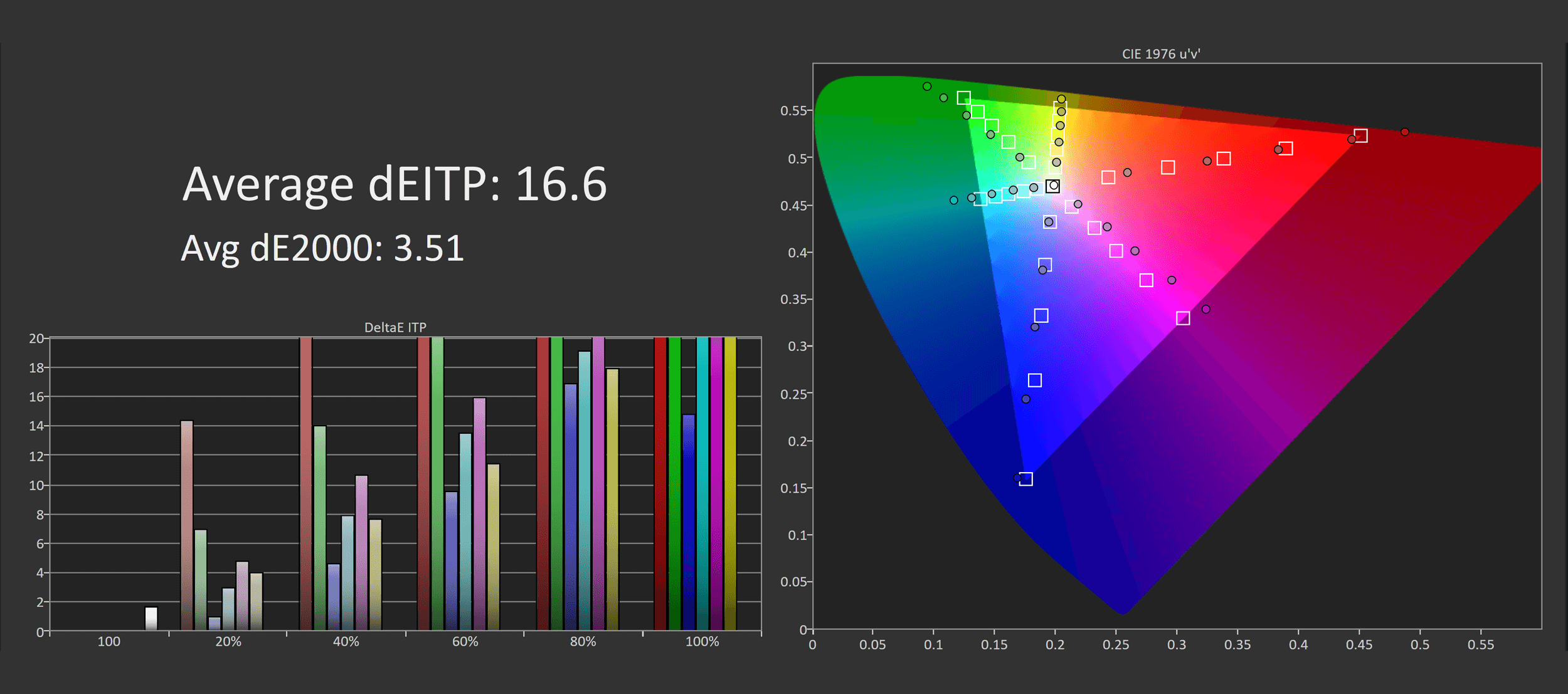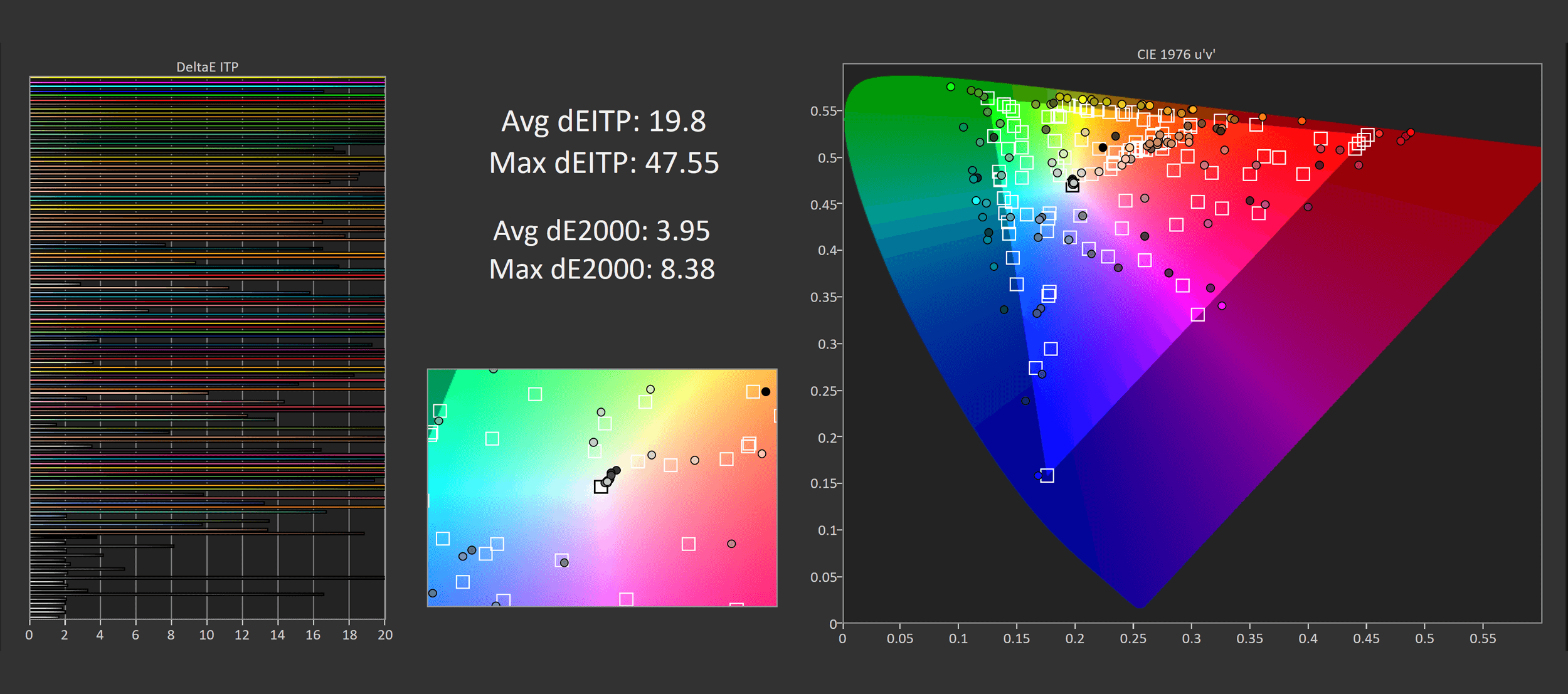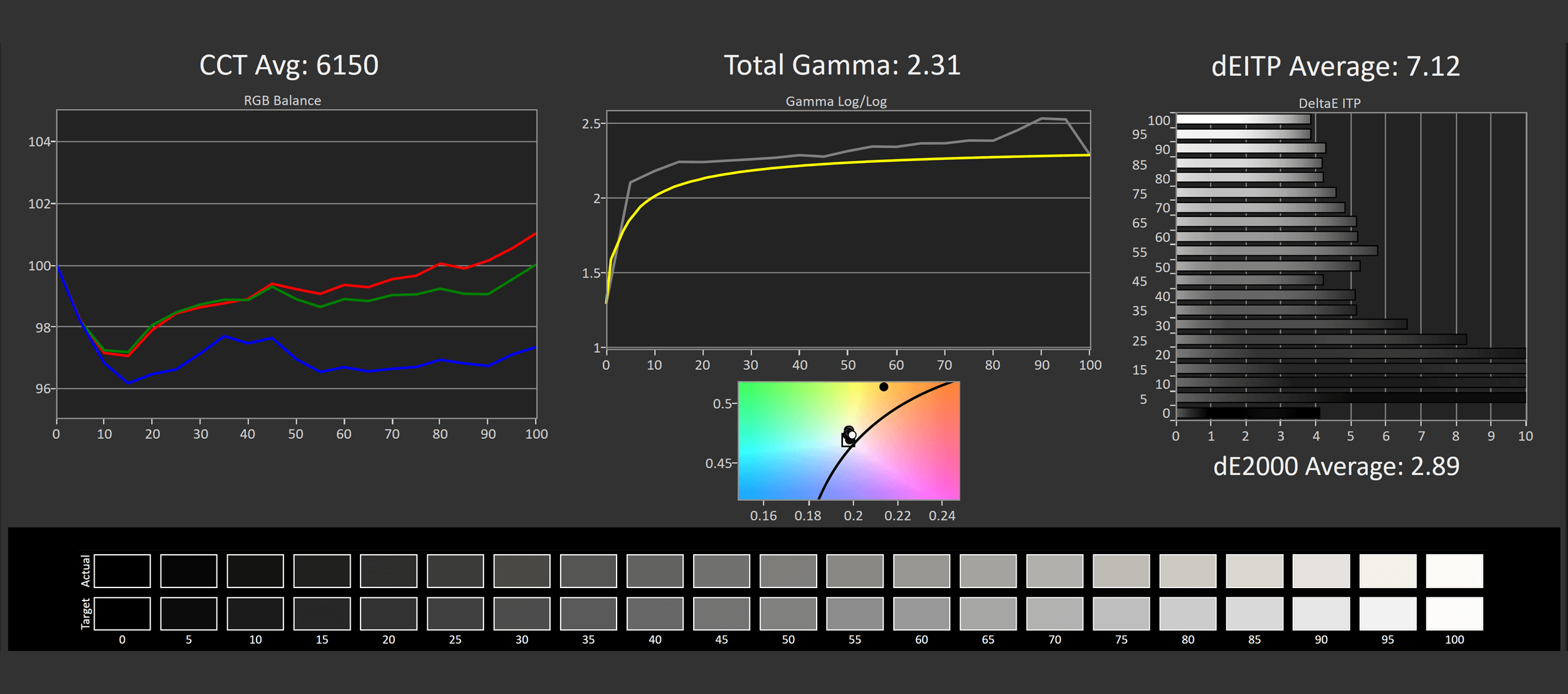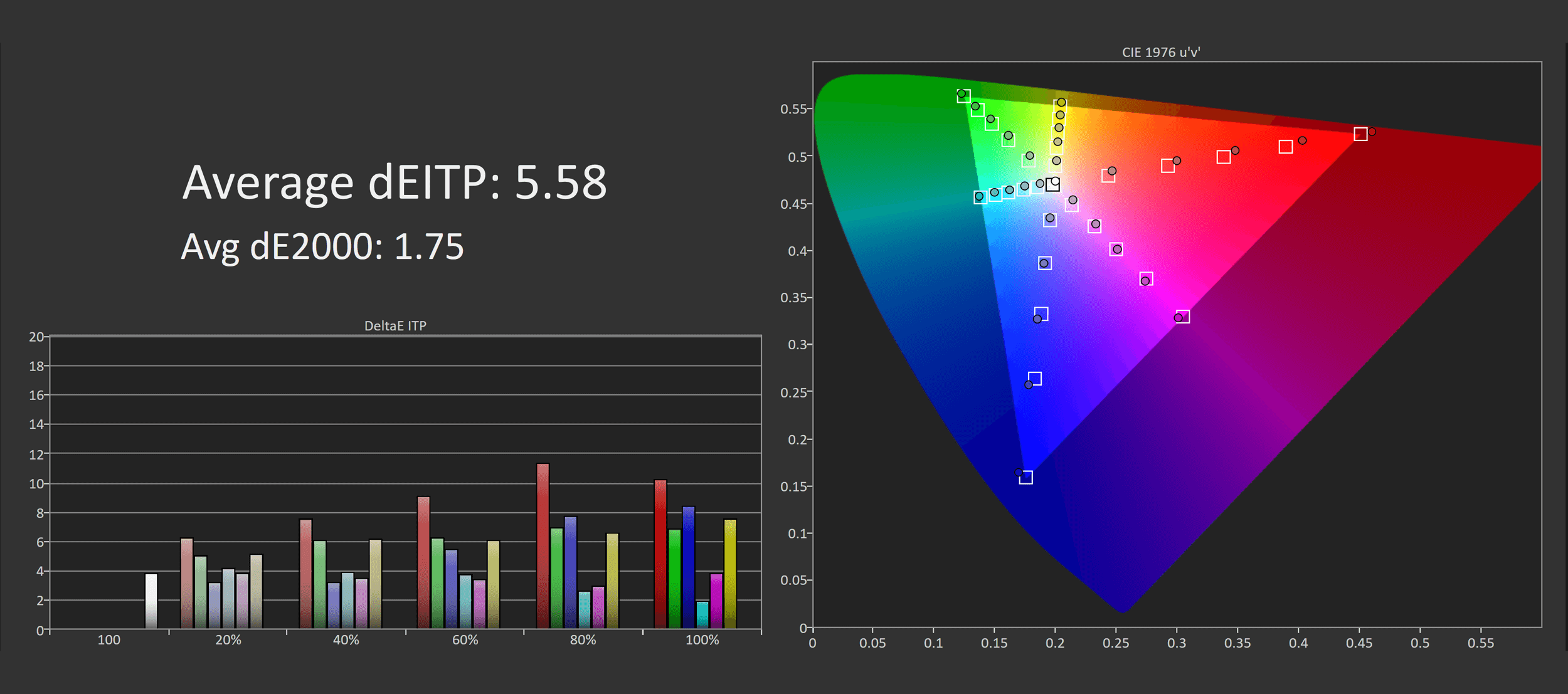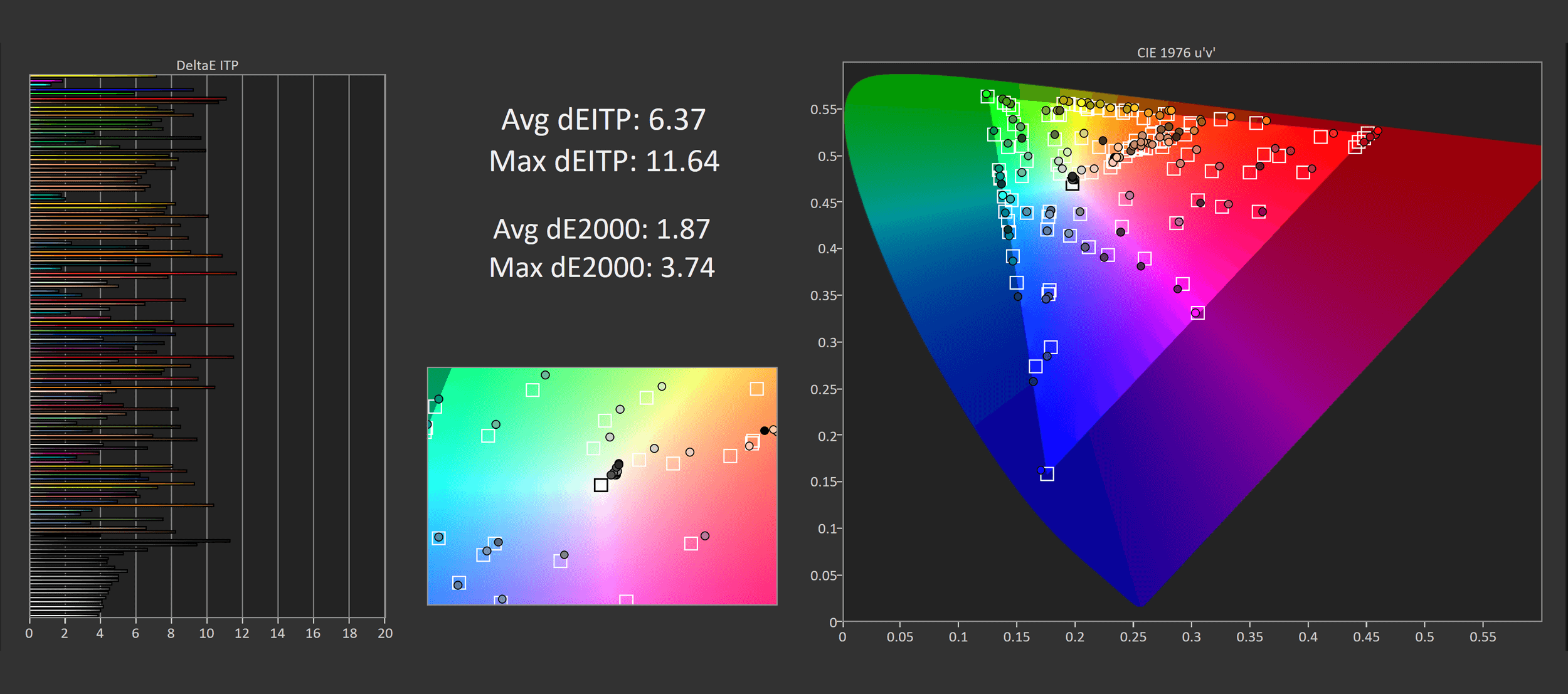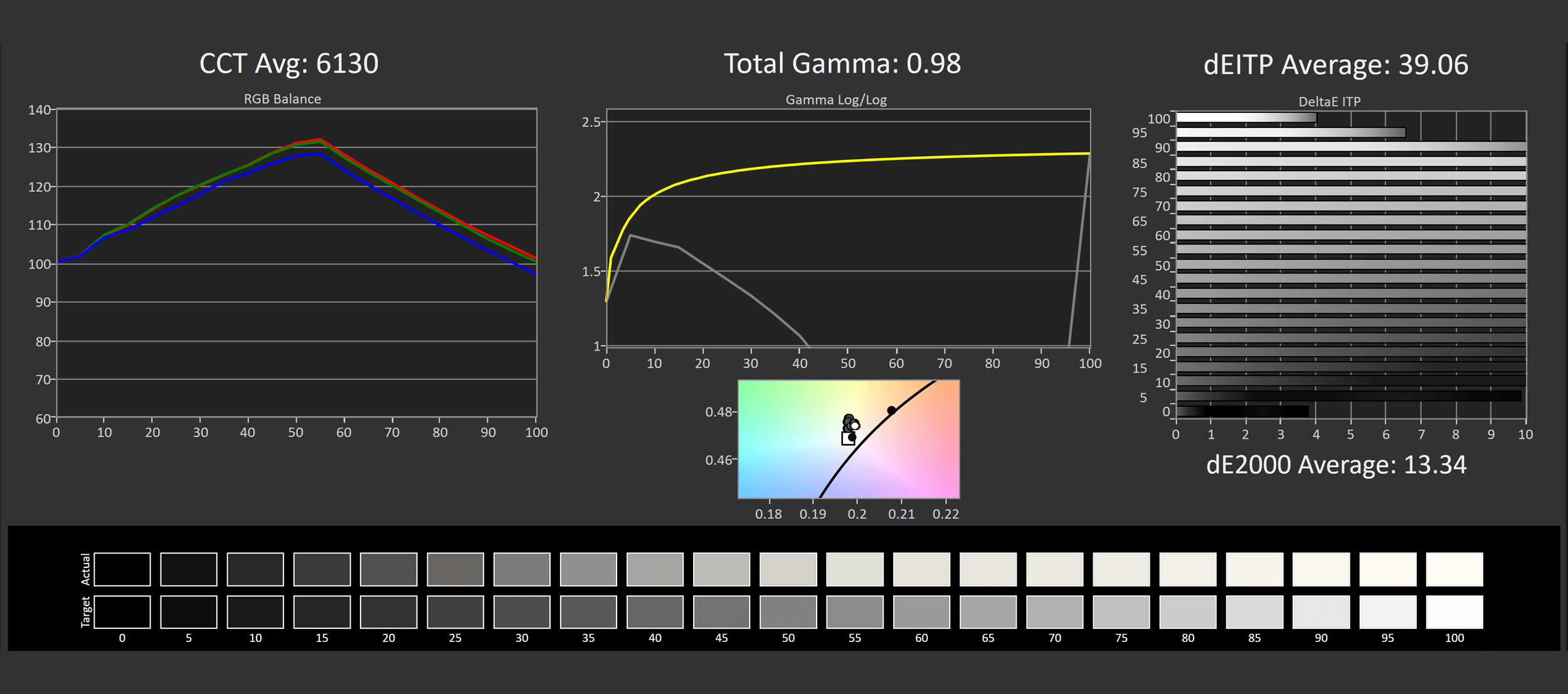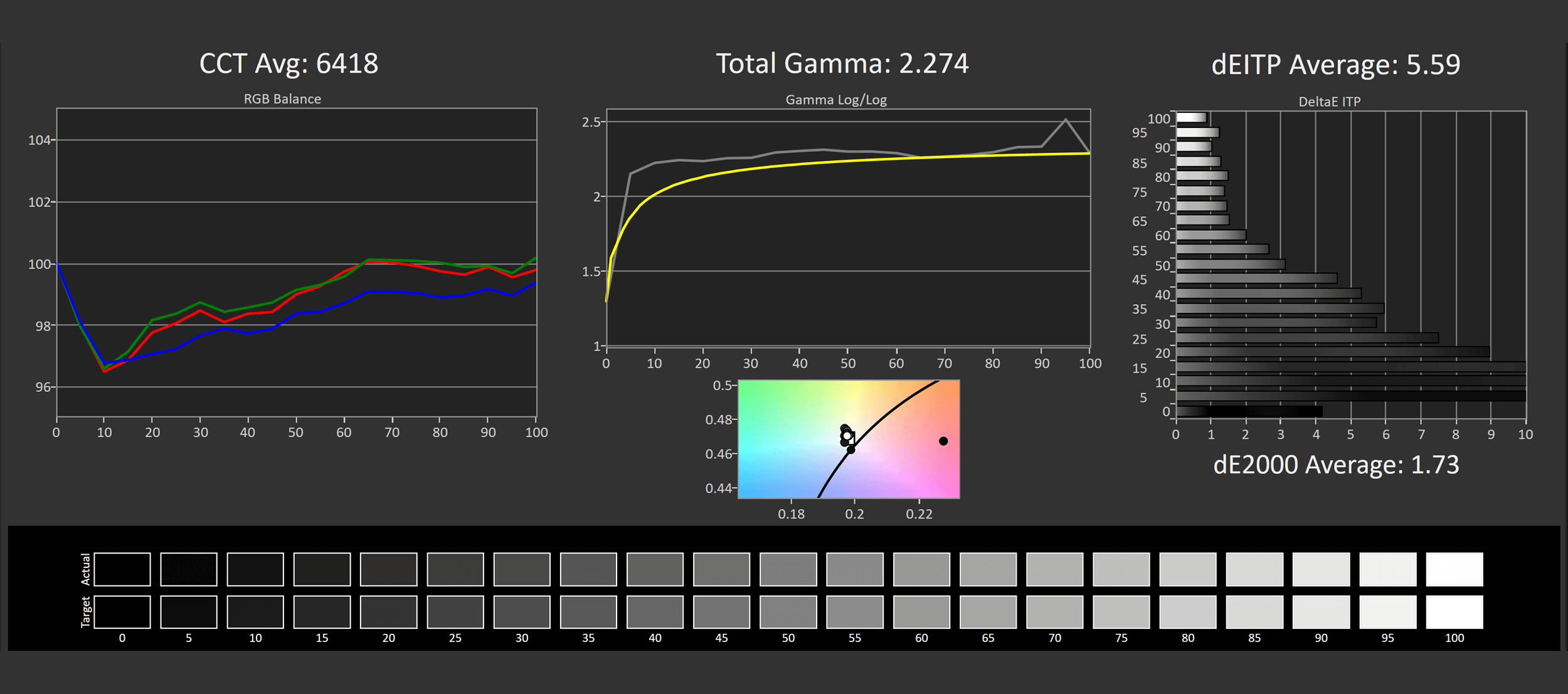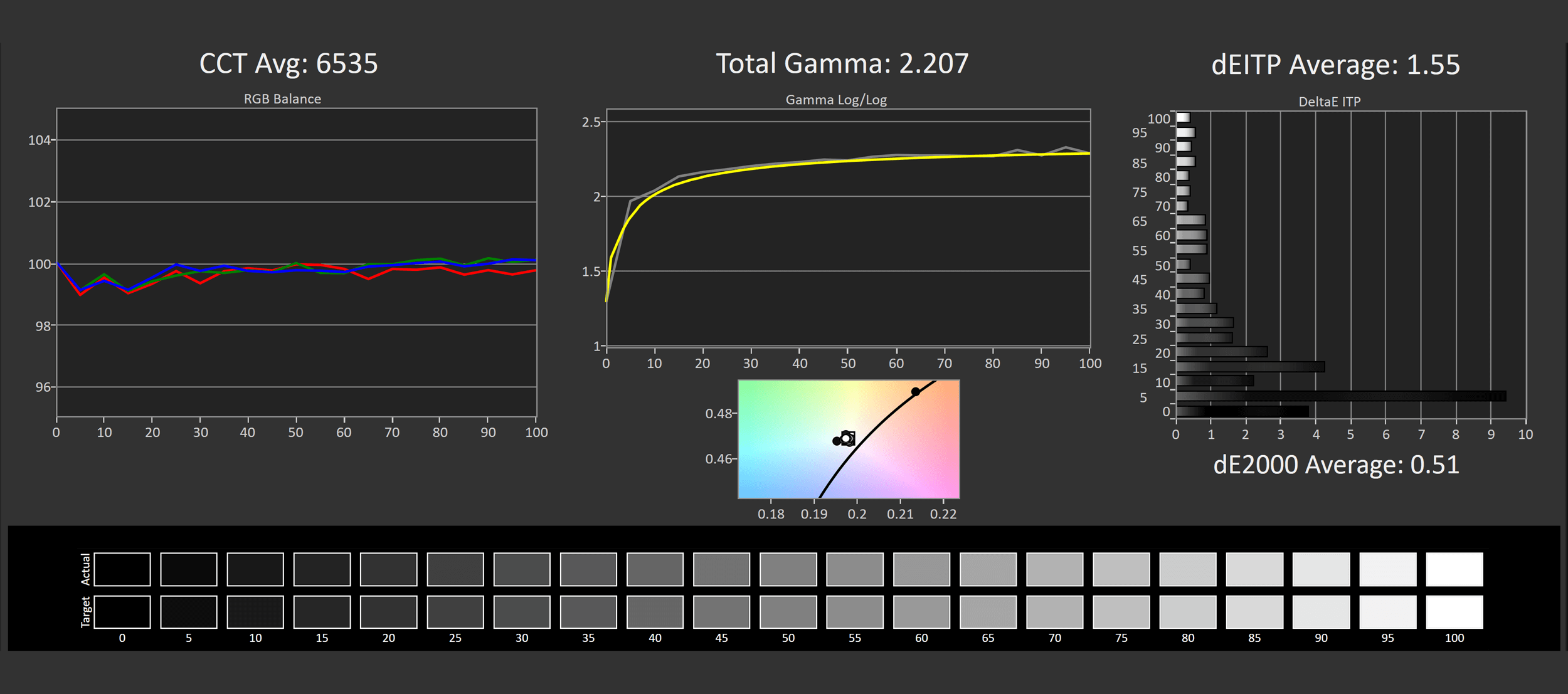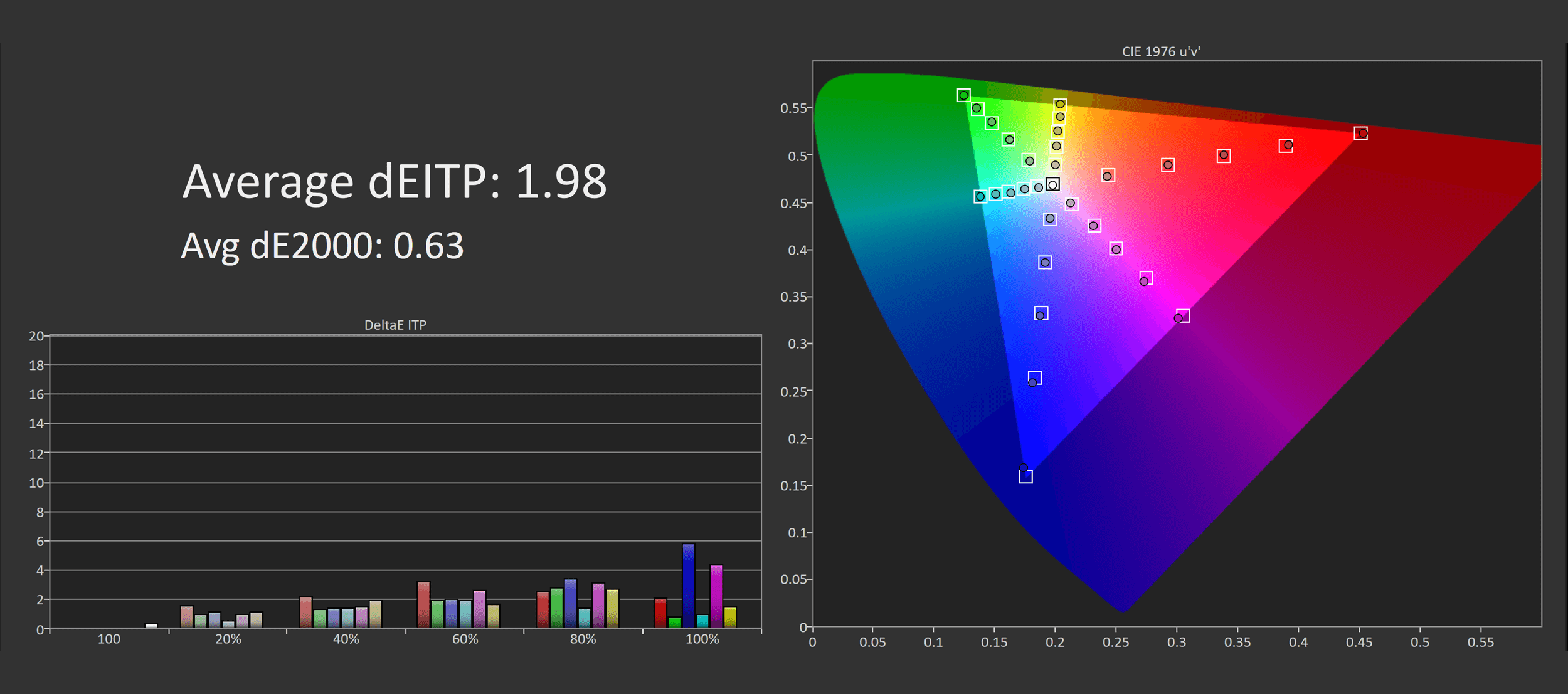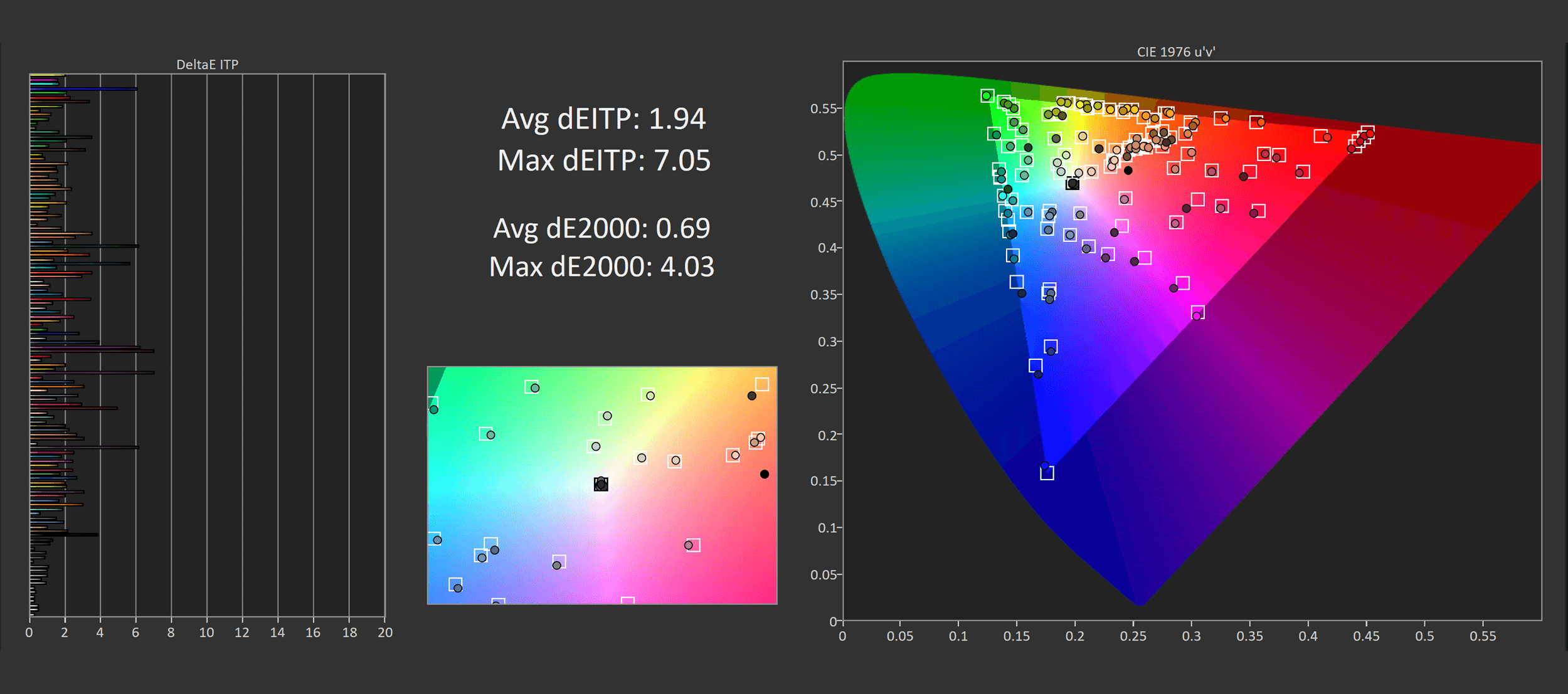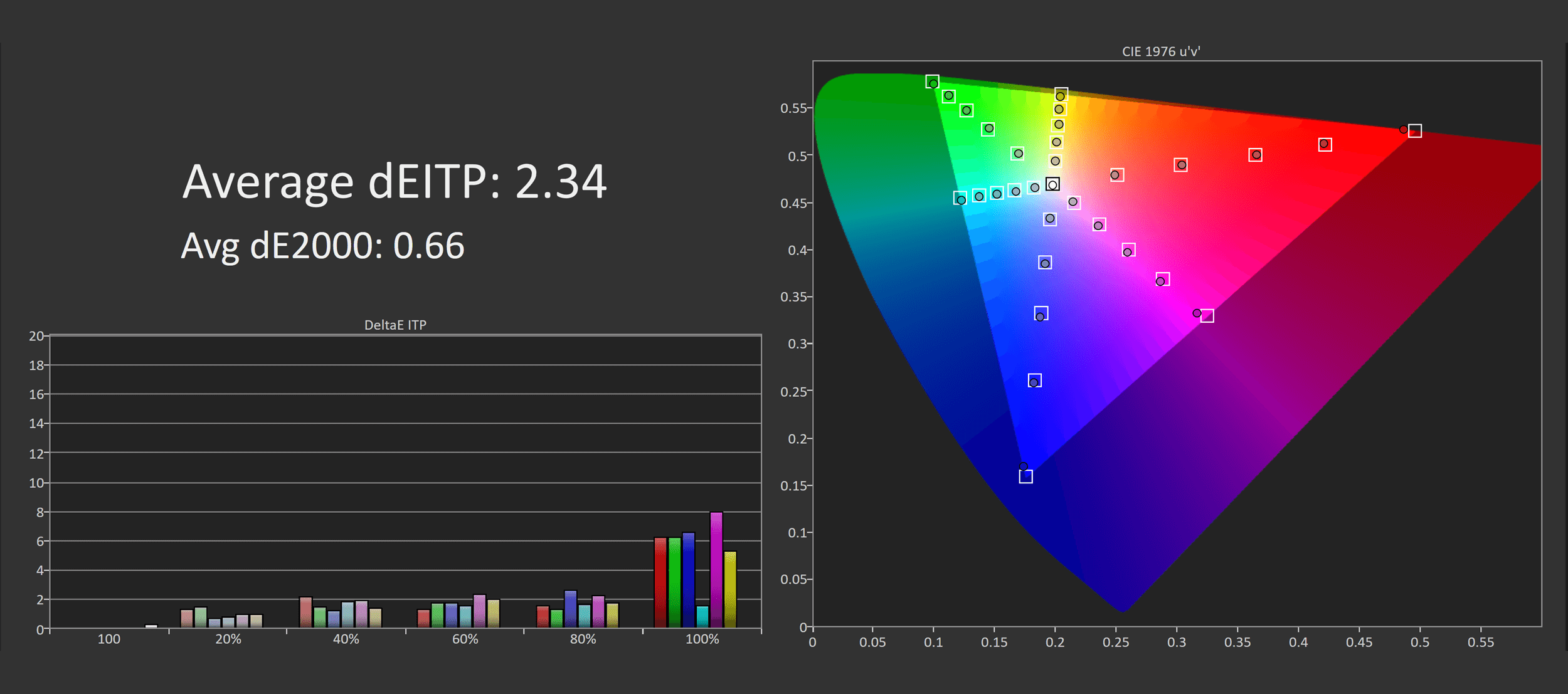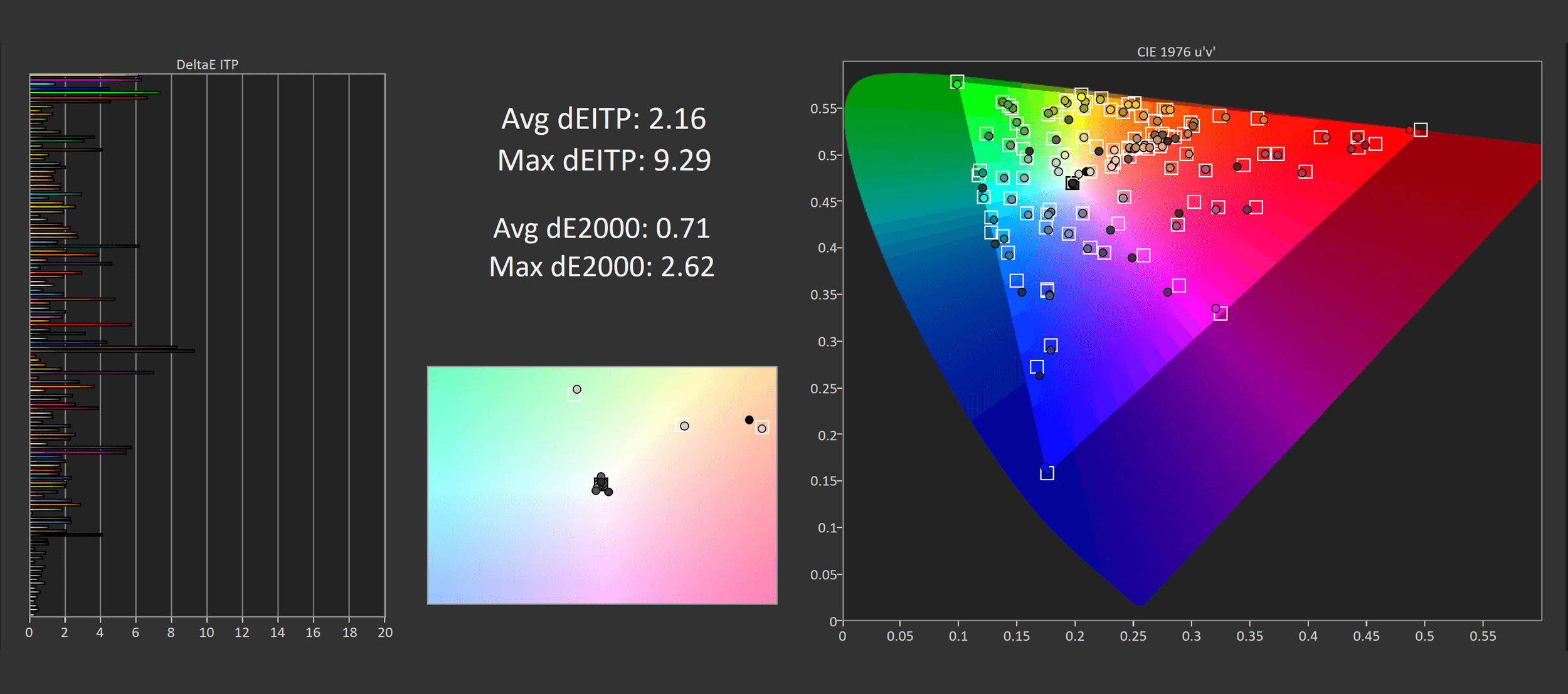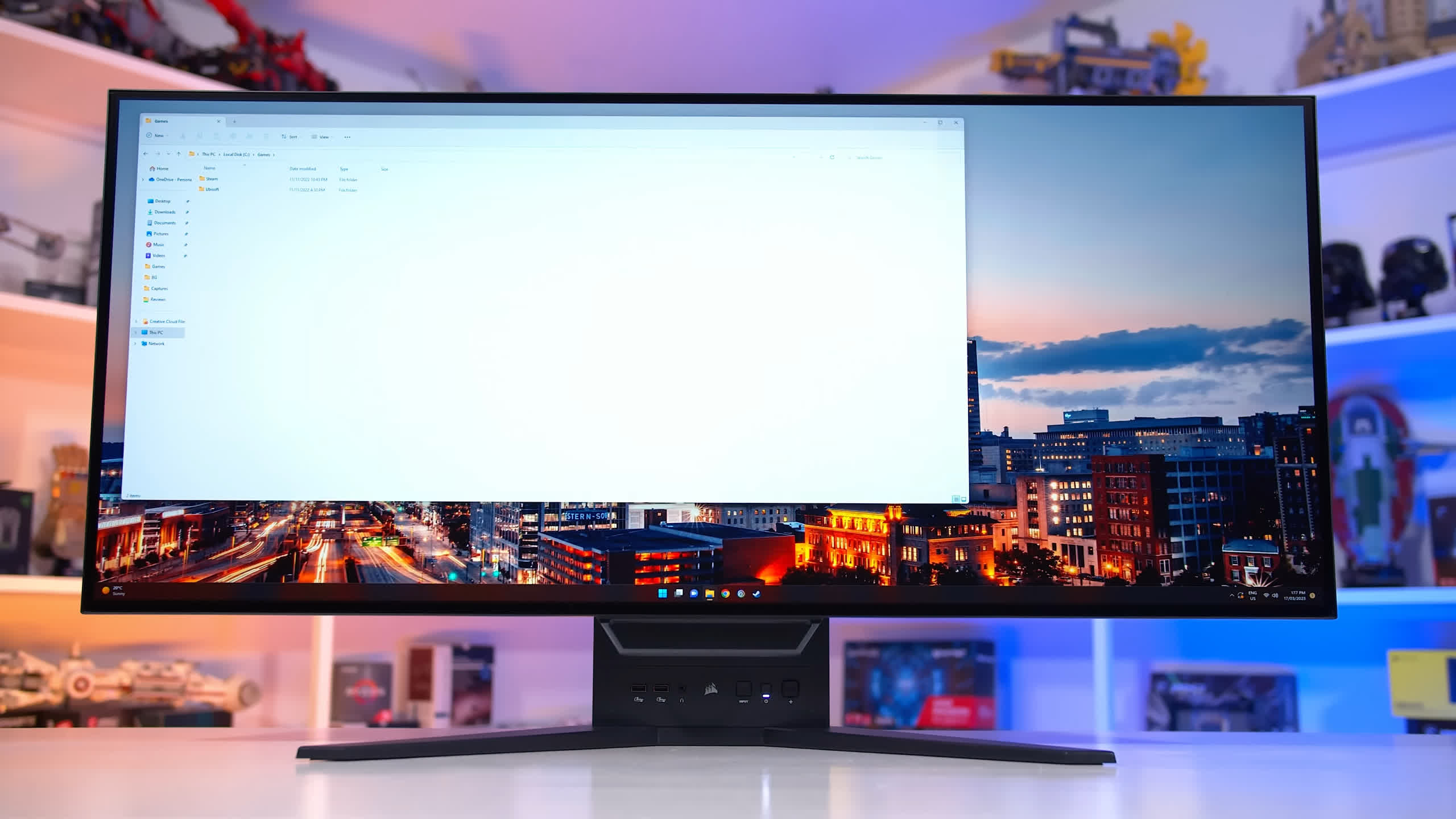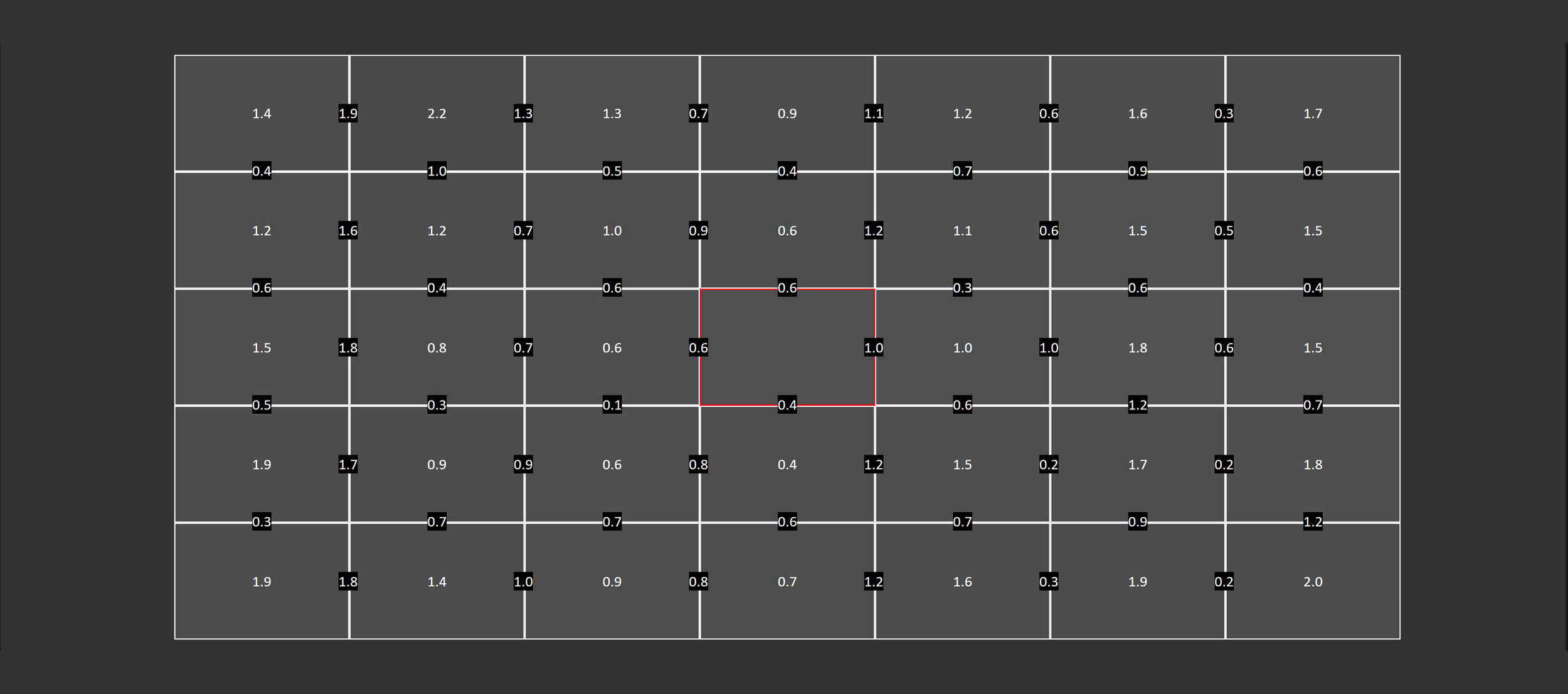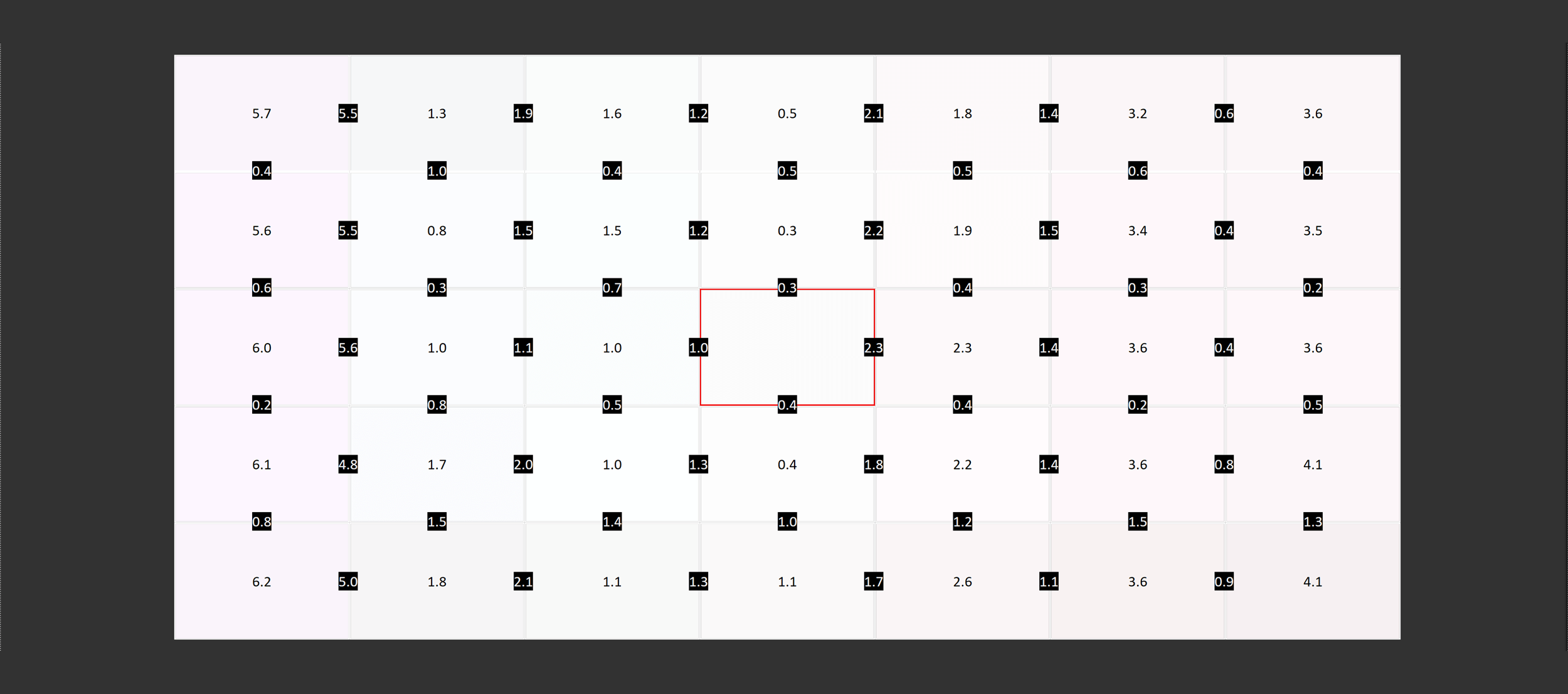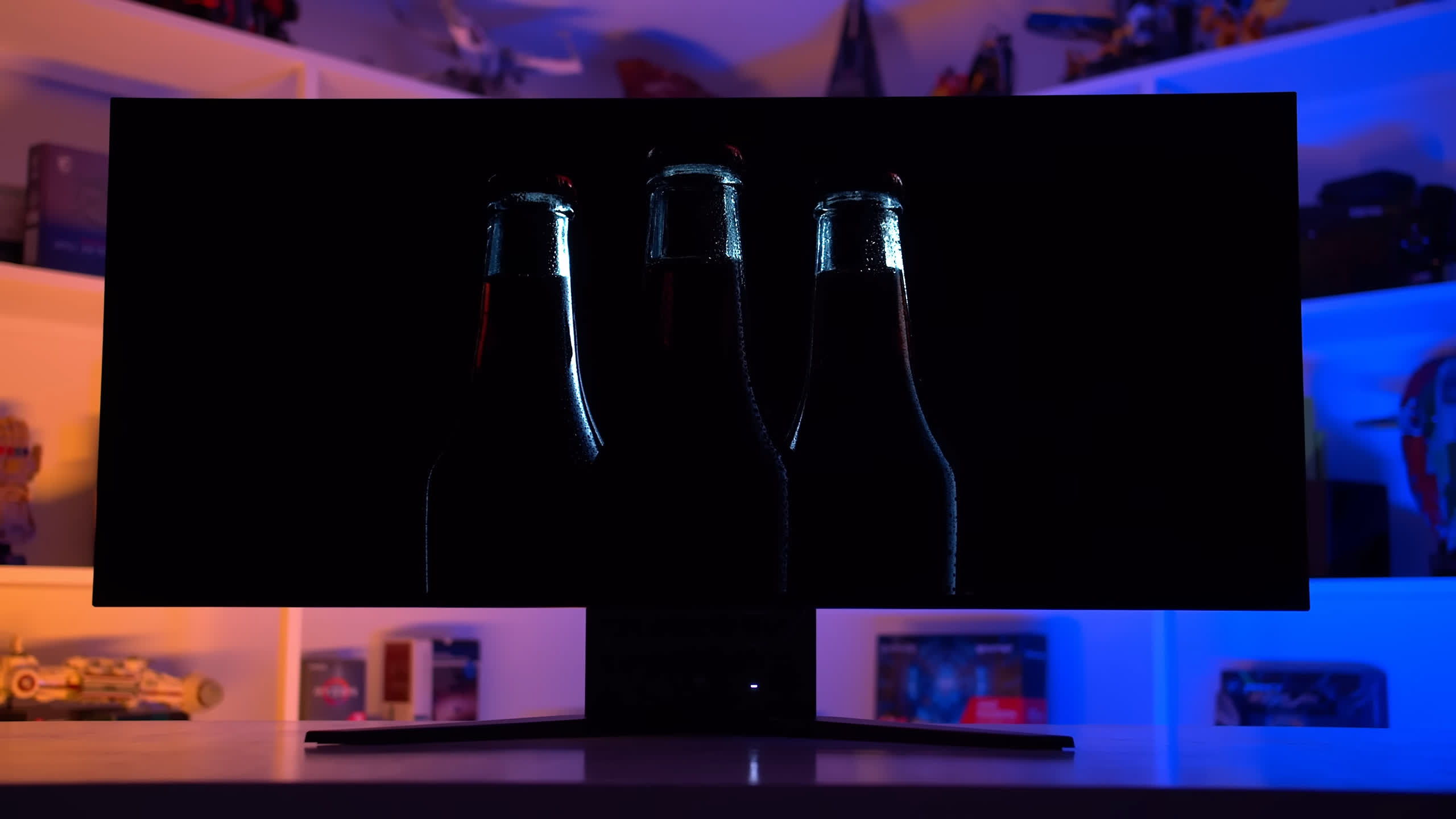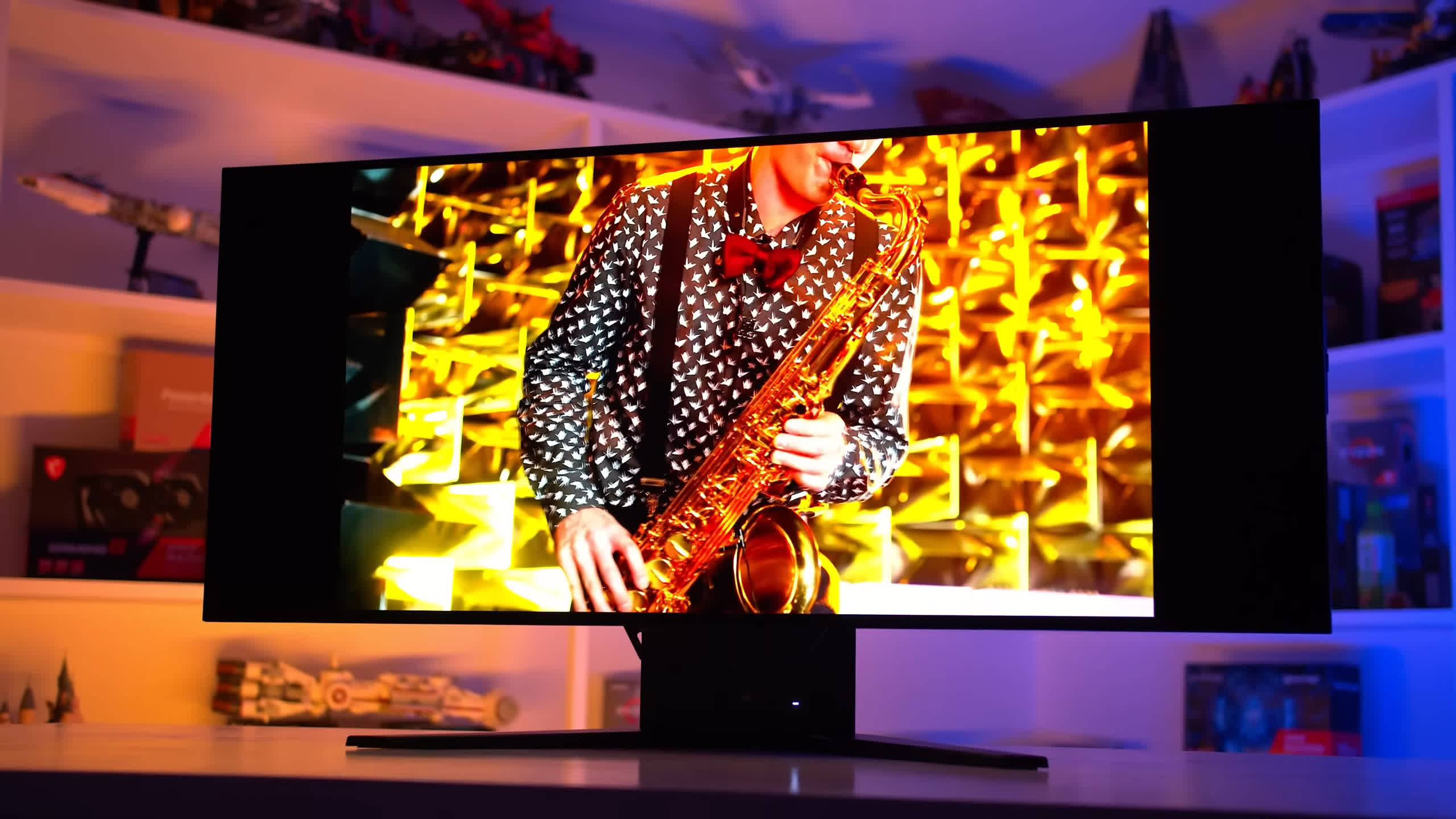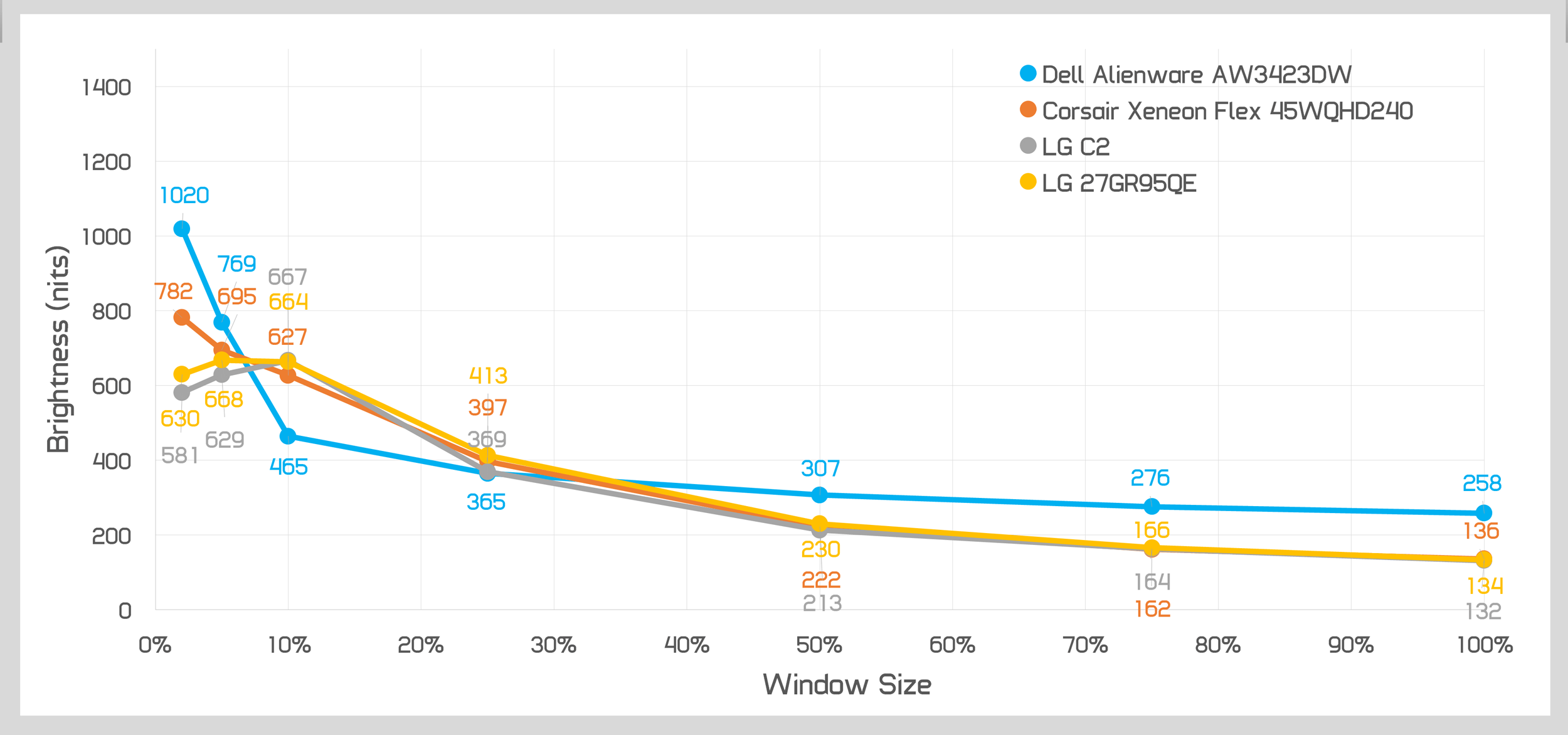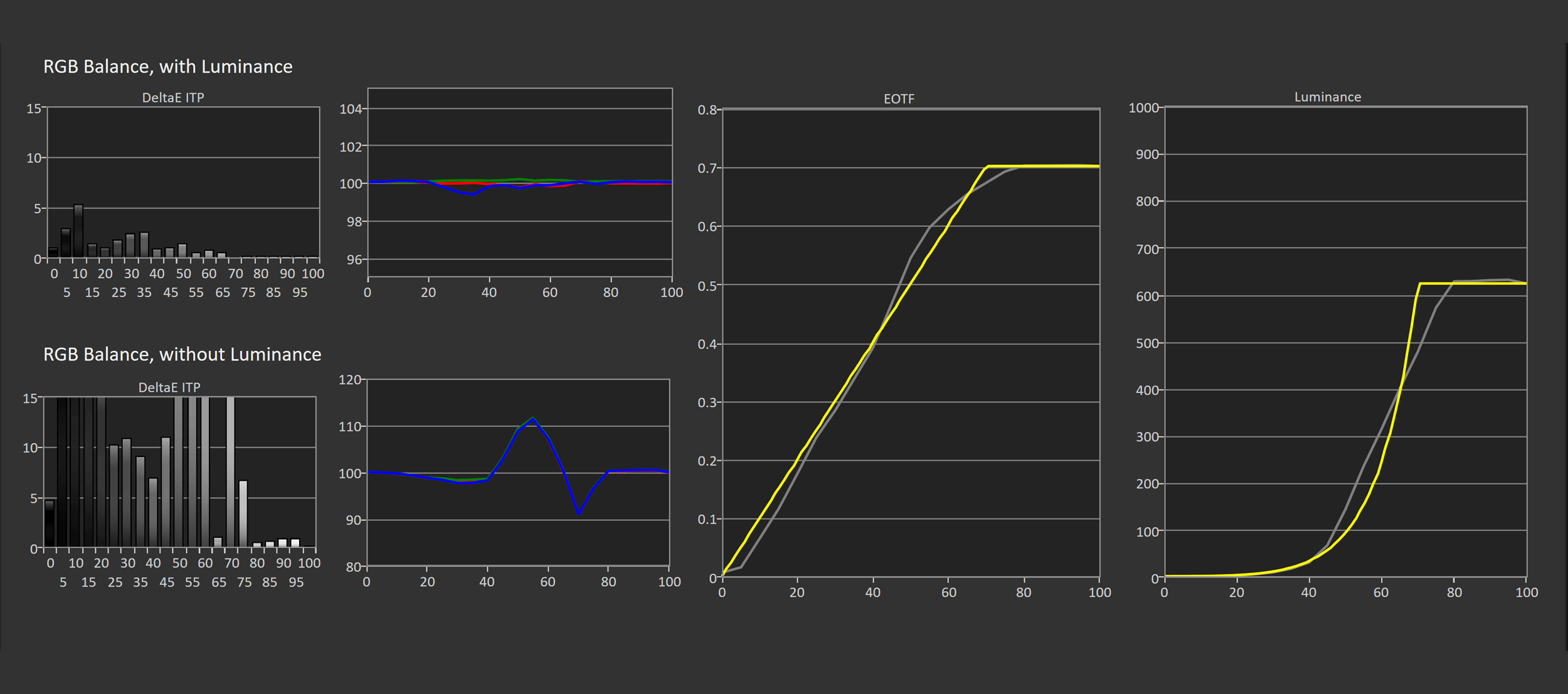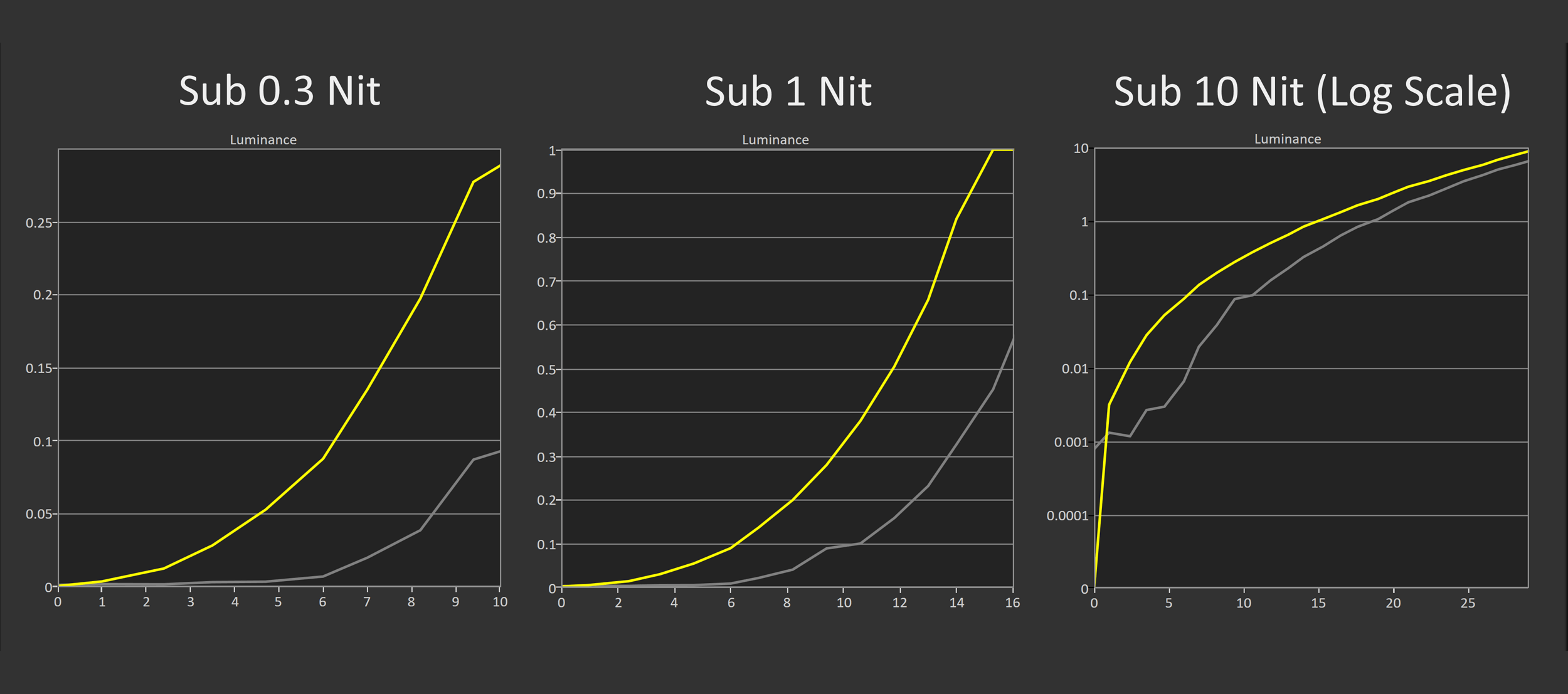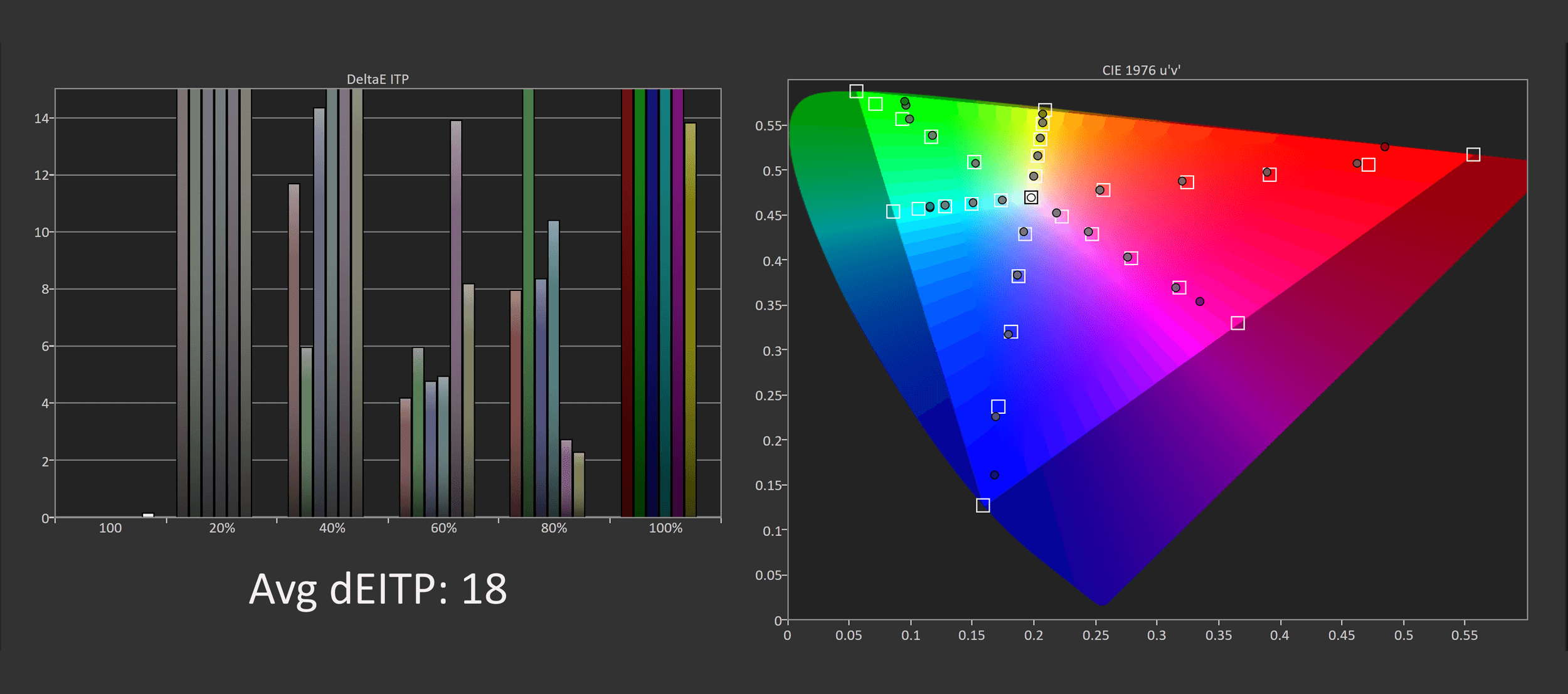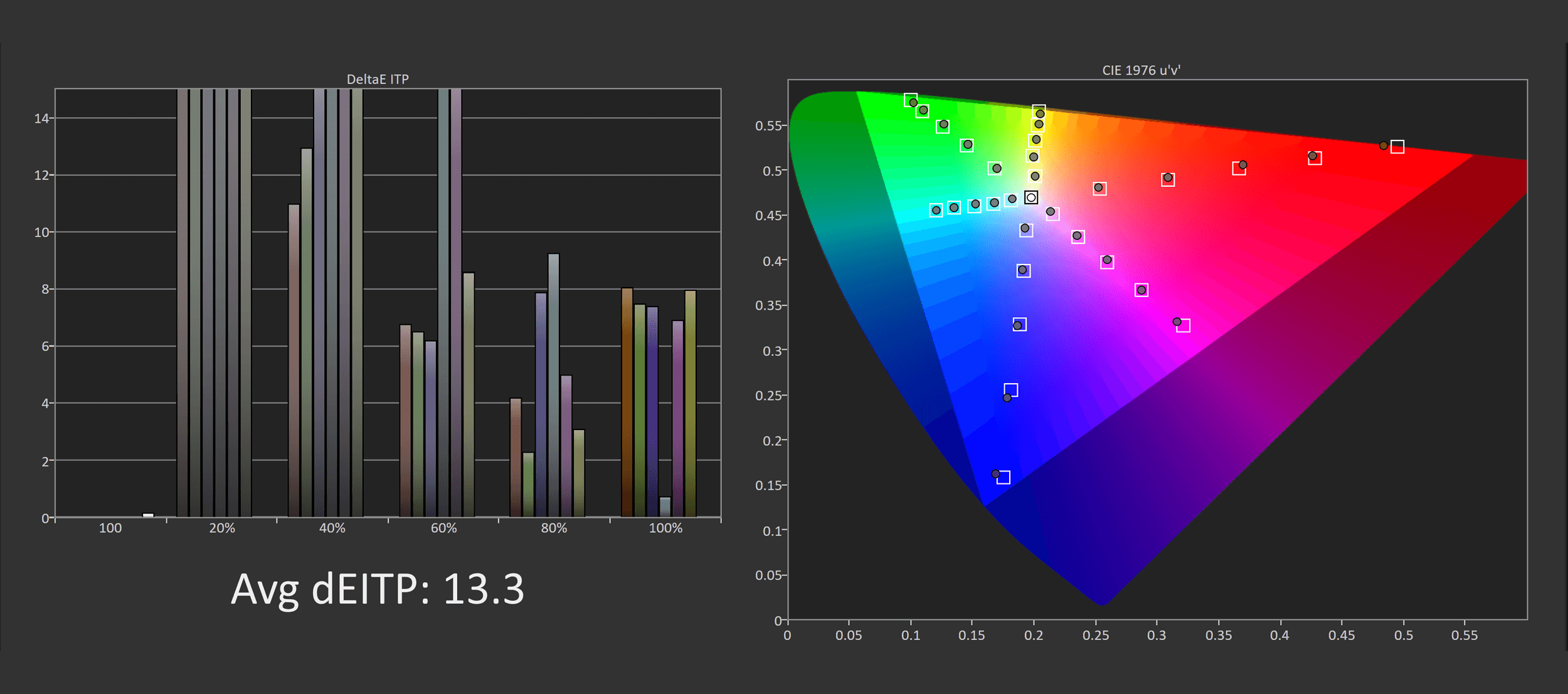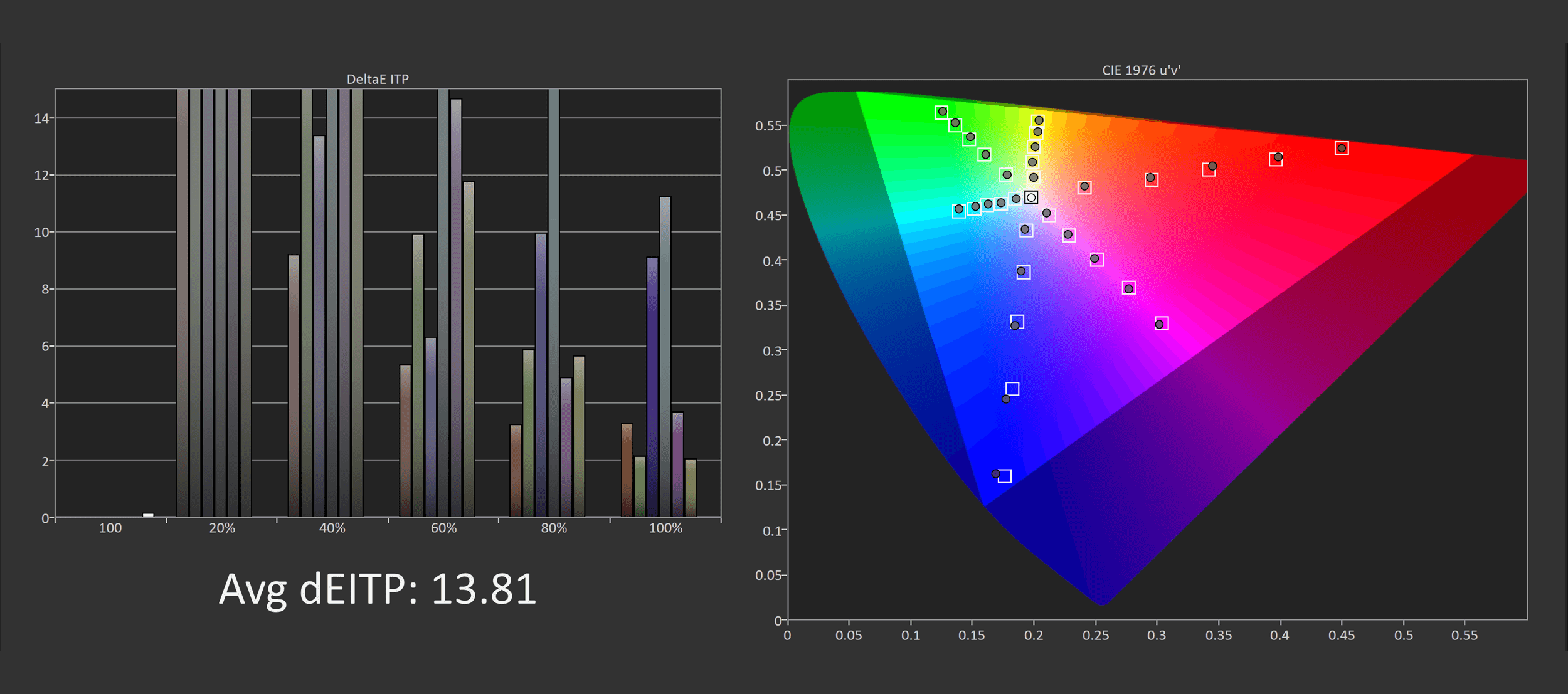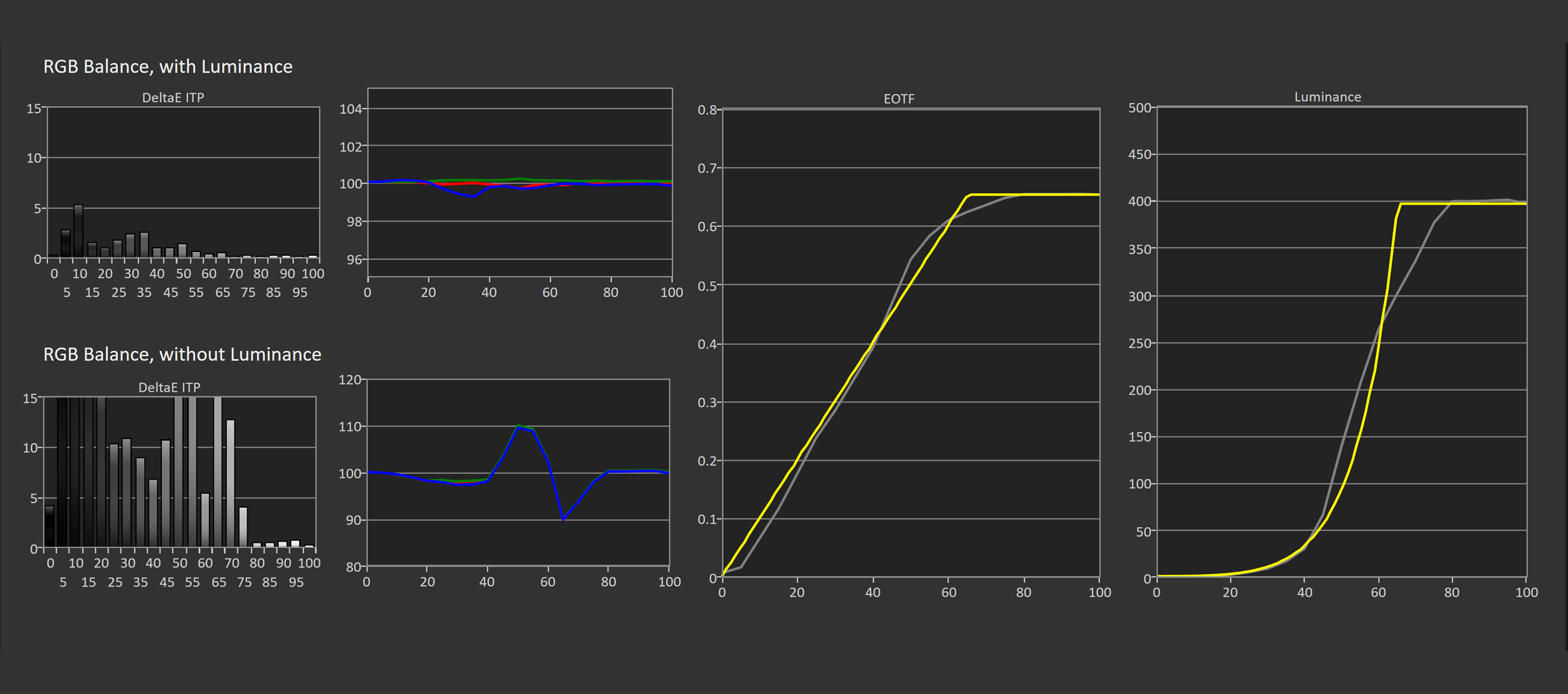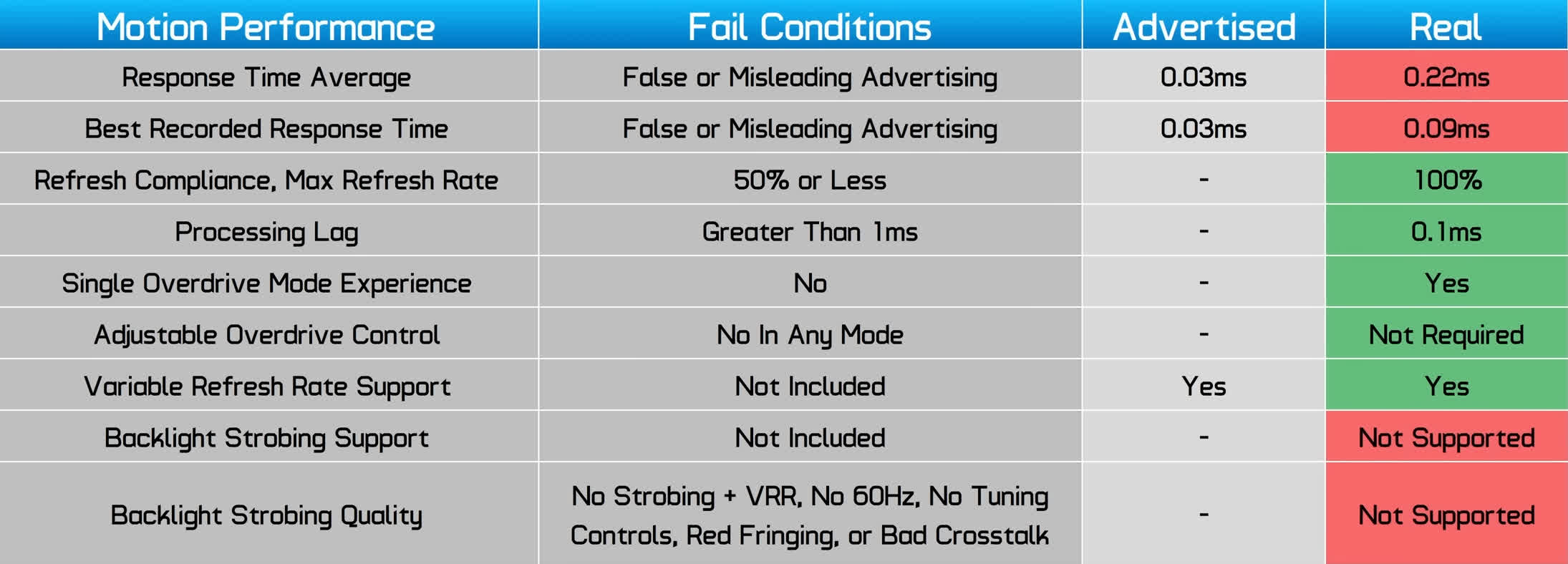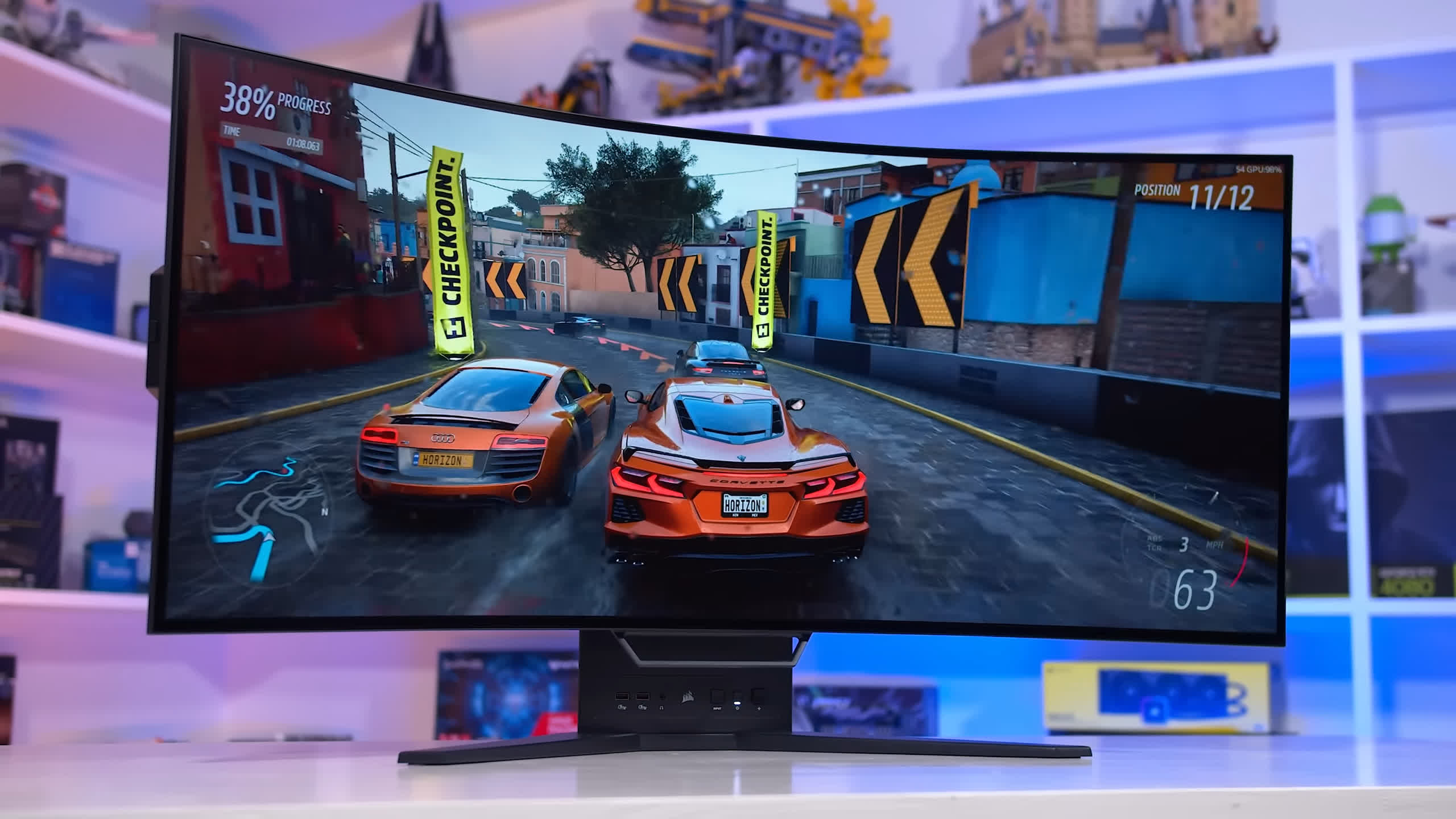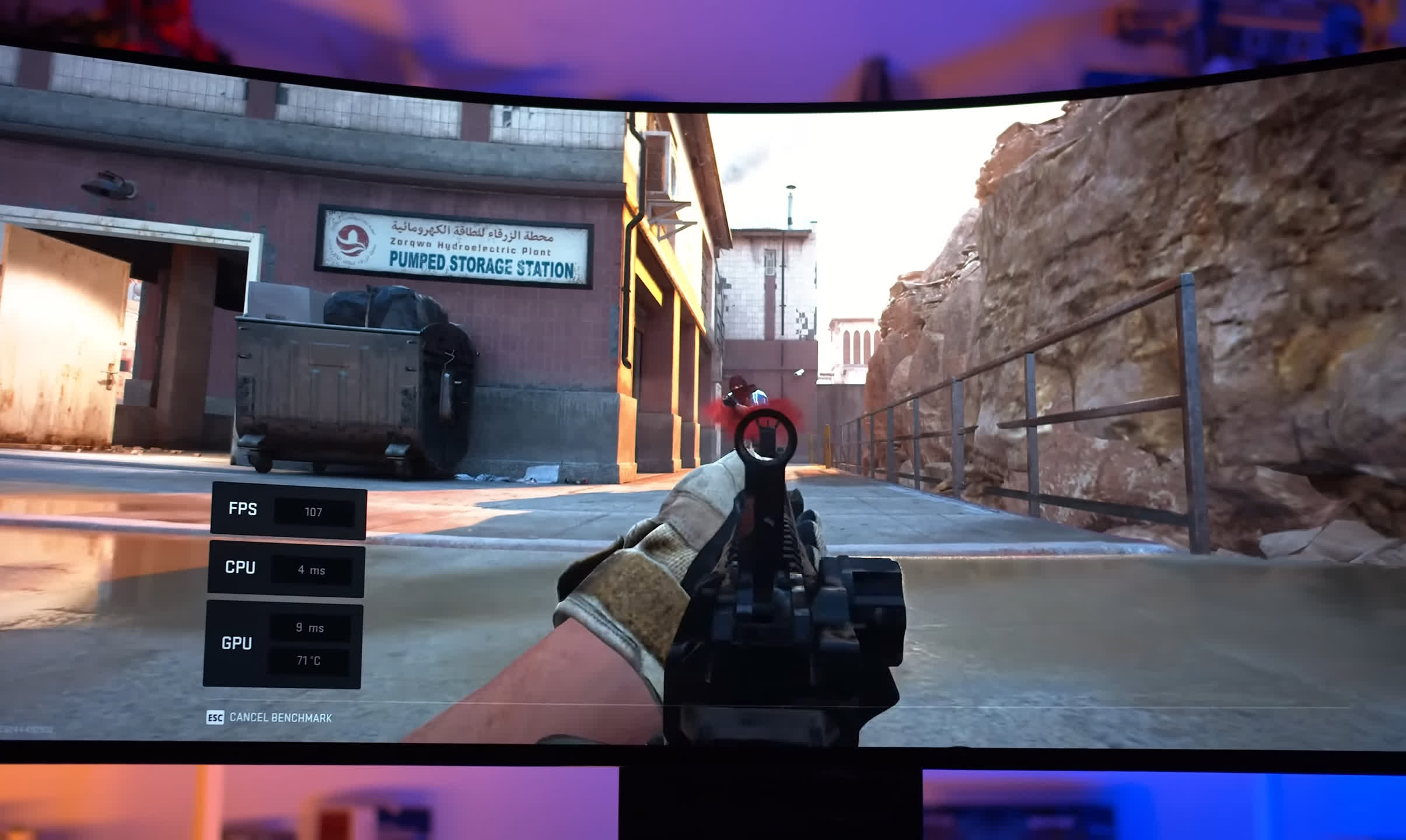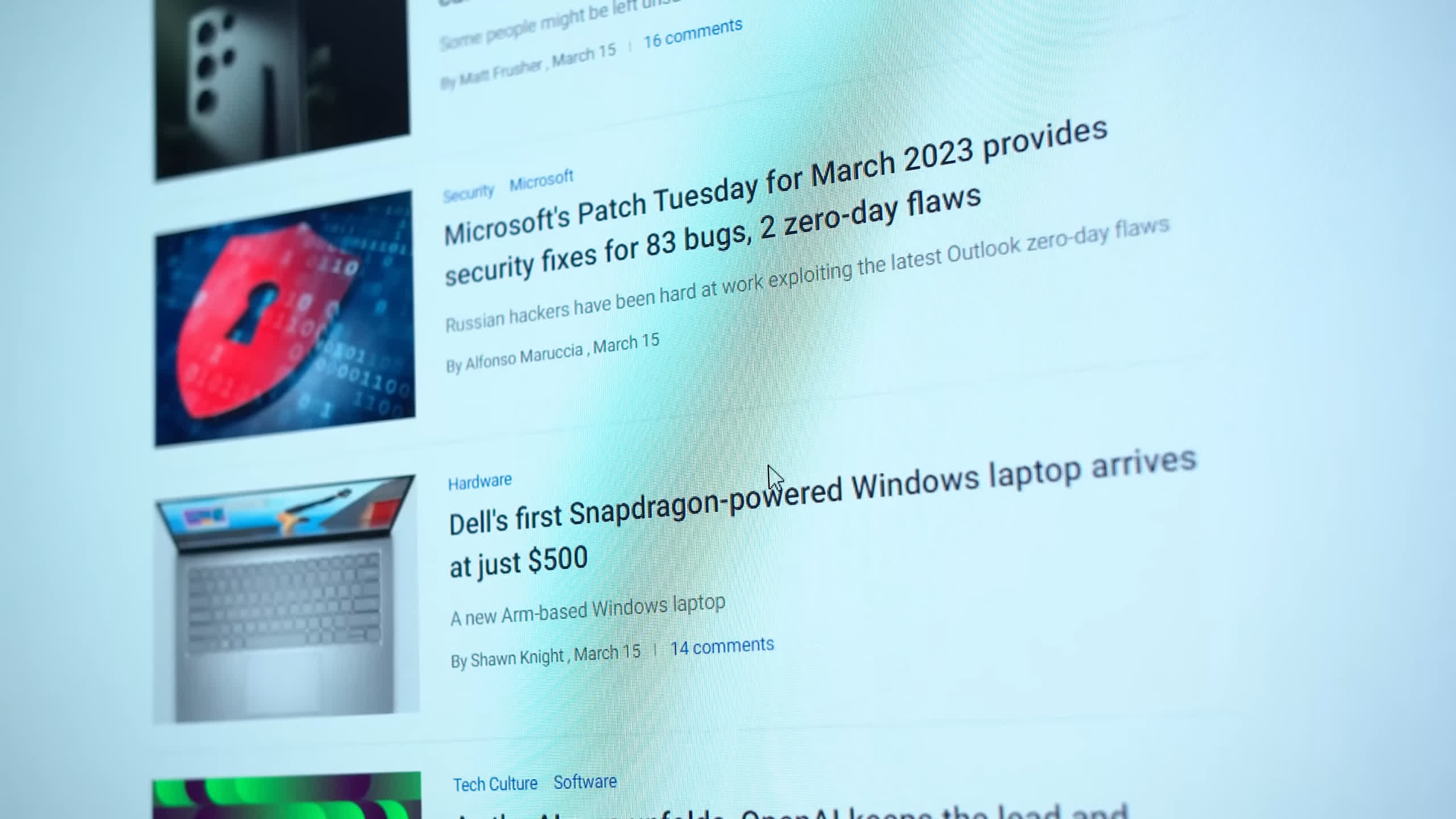The Corsair Xeneon Flex is an interesting and unique monitor that provides an adjustable curvature, so needless to say, there are very few products on the market that can compare to it. We always love to see innovation and new ideas come to market, as many monitors in particular end up being very similar to each other, but you can't say that about the Xeneon Flex.
The Corsair is a 45-inch 3440 x 1440 WOLED ultrawide panel with a 240Hz refresh rate. It supports HDR with up to a claimed 1000 nits of peak brightness, adaptive sync from both AMD and Nvidia, plus rapid 0.03ms response times. But the unique and key selling feature, is in its name: Flex.
This monitor has a flexible OLED panel that can be adjusted into any curvature from flat to a very curved 800R. All you have to do is extend the handles on either side, pull the display in to your desired curve, retract the handles and you're set. Want to adjust it later for a different use case? Just repeat the process any time you like.
When I first saw this monitor in marketing materials I had a lot of questions about how it works, so I'll try and answer them for you here. It takes a fair bit of force to bend the display, which is a good thing as when you bend it to the degree you want, it stays in that place and won't bend easily from an accidental knock. But it's also a smooth process, so for the most part it does feel like the display is meant to flex and there's no obvious creases when you do so.
There are two handles on either side of the display, but they are independent of one another, so it is possible to create an uneven curve, such as flat on one side and curved on the other. But it's not really possible to over-bend the display, the arm and handle mechanism on the back prevent excessive bending, and there is an audible click when you reach the limits of the bend. However, at least when bending the display back to being flat, the click occurs slightly before the panel is completely flat so I needed to keep bending it slightly to get it flat as I wanted.
My least favorite part of the bending mechanism is actually the way the handles retract, the rest of the mechanism feels quite sturdy but these handles are janky and don't smoothly come in and out along their rails. That part of the design could have used a bit more work.
The idea behind having an adjustable curve does make sense. Curved monitors can be controversial and users tend to have preferences for the perfect curve, whether that's 3600R, 1800R, 1000R or no curve at all.
With the Xeneon Flex you have the choice to set it how you like, a unique feature among monitors and the range of adjustment here should cater for everyone. For me personally I found that around three quarters of the way to maximum curvature suited me the best. It also allows you to change the curve depending on the use case.
It really is a useful feature. Many new monitor innovations are simple gimmicks, but I don't feel this is the case with the Corsair Xeneon Flex at all.
While gaming you might want to have the monitor very curved, so the edges of the screen are within your field of view, but for using the monitor for content consumption you might like it in a flat configuration to reduce distortion. It really is a useful feature. Many new monitor innovations are simple gimmicks, but I don't feel this is the case with the Corsair Xeneon Flex at all.
Design
Being a 45-inch display, the Xeneon Flex is very large, much larger than a standard 34-inch ultrawide - you're getting roughly 75% more screen real estate. It's the same sort of display width as a 48-inch 16:9 monitor, but obviously shorter to give it a 21:9 aspect ratio, so you'll need a lot of space to fit this in your setup, and you might need to sit further back than usual to see the whole thing properly.
It also has a rather unique design aside from the whole flexible display thing. The main electronics are housed in the stand and while there is also a box on the rear of the display itself, the stand and display are clearly meant to be used together and can't be separated.
This eliminates two key features that you see on most other monitors: height adjustability and VESA mounting. This gives the monitor very limited adjustability, just tilt support, and you can't mount it to anything else, so if you wanted it to sit a bit higher up for example... well, sit on some books, I guess.
Aside from those omissions, I was impressed with the build quality. The front of the display looks great with a good bezel size, the thin OLED panel is on show from the sides and on the rear it looks quite sleek. Even the handle and bending mechanism is well integrated and the stand doesn't feel particularly large despite housing all of the ports.
All of the ports on the rear are easily accessible as they're arranged in a strip down the middle. This includes two HDMI 2.1 ports, a DisplayPort 1.4 port, and a USB-C port that supports DP Alt-Mode.
In addition to this, there's another USB-C upstream port for facilitating the USB hub, which includes two ports on the rear, and two on the front in an easy to access location, one of the benefits of the stand housing all the ports. However, the HDMI 2.1 ports are just 24 Gbps, so they require DSC to provide the full 240Hz at 3440 x 1440. This works just fine on desktop PC GPUs, but devices that don't support DSC will have a few issues.
The OSD is controllable through a directional toggle, positioned on the stand next to the USB ports. It has a pretty standard set of features, nothing overly flashy, including crosshairs which we probably wouldn't recommend using on an OLED. There's also a few basic OLED care features like pixel cleaning and pixel shifting, but there's no KVM switch, which would have been a useful inclusion on a monitor with four display inputs.
The coating on OLEDs is another controversial aspect to this latest generation of high-end monitors. The Corsair Xeneon Flex uses the exact same matte anti-glare coating as the LG 27GR95QE, which I think is pretty good. It does a great job of handling direct light sources, it doesn't reflect as much diffuse light as many LCDs I've seen and even in brighter usage conditions it preserves a lot of what makes OLED great in its deep blacks. I also don't think the coating makes the screen look particularly blurry or like it has a "coating of Vaseline," but it is on the heavier side, so if you're super sensitive to matte coating grain then this will be somewhat more noticeable than lighter coatings.
In general, if you are using this display in a brightly lit room, if there are light sources directly in front of the display or if you can't control room lighting very well with blinds, a matte coating for an OLED is preferable to glossy and the Xeneon Flex looks great in these conditions. In a dimly lit room with some ambient light, or if you can optimize light in the room by putting light sources behind the display or using blinds, a glossy finish is preferable as it will look richer and clearer. In a dark room, like gaming with the lights off, there is almost no difference between glossy and matte, with a slight advantage to glossy as it will have no coating-related grain.
The biggest issue with this monitor in my opinion is text clarity. The Xeneon Flex does not render text well, and this is down to two flaws with this display: a low pixel density, and an unoptimized subpixel layout.
This is a large 45-inch monitor but it only has a 3440 x 1440 resolution, the same resolution more commonly seen with 34-inch displays. Given this 45-inch screen is 75% larger, the pixel density is a lot worse, equivalent to a 27-inch 1080p display, or 55-inch 4K display, at just 78 PPI.
Most high-end gaming monitors these days give you at least 110 PPI or so - for example, that's what you get with a 27-inch 1440p monitor - and of course, 4K pushes that density up further. The Flex's pixel density is inadequate for a desktop monitor in 2023.
It also compares poorly to other OLEDs. The most dense OLED tech we have at the moment delivers around that 100 to 110 PPI mark, as seen in the 34-inch QD-OLED ultrawides, as well as the LG 27GR95QE at 27-inch 1440p, and the LG C2 at 42-inch 4K. I'm not sure why LG opted for 78 PPI density when designing their 45-inch panel, I would have thought using the same density as the 27GR95QE or 42-inch C2 panels would make a lot more sense.
The low pixel density is compounded by WOLED's use of a RWBG subpixel layout. Modern subpixel text rendering engines like we see in Windows are expecting and are optimized for standard RGB stripe subpixel layouts, which are used for the vast majority of LCD panels today. When you introduce a different layout instead, especially an usual layout with a fourth white subpixel like these LG OLED panels, it hurts text rendering and causes artifacts. RWBG artifacts are typically what I'd describe as shadowing on the left side of text, as well as just a bit of blurriness relative to an RGB stripe LCD, today's gold standard.
On a reasonable density panel like the 27GR95QE I found this noticeable, so when the panel is larger and pixel density gets worse, naturally these artifacts are even more visible on the Xeneon Flex. Text just doesn't look good on this monitor, it lacks that sharpness and clarity you get from other high-end options.
This makes the Flex hard to recommend for productivity work. Desktop apps that feature a lot of text like web browsers, email clients, spreadsheets and so on just don't look amazing on this display. This is compounded by the permanent burn-in risk associated with OLEDs. Using static desktop apps for long periods like you normally would in a productivity setting is probably going to burn in the display after a period of time, which isn't ideal. With that said, I wouldn't be concerned about burn in if you're primarily using this display for content consumption, as the mixed nature of content like videos and games is unlikely to cause noticeable burn in.
But even with other OLEDs I could occasionally see someone using it for a bit of web browsing in between gaming sessions, that's pretty unlikely to cause burn in damage. But the text rendering of this monitor does hurt that experience so this is the least suitable OLED I've seen for desktop apps so far.
Display Performance
Motion performance is similar to other OLEDs. The Flex is capable of elite speeds at 240Hz, delivering excellent motion clarity. On average, we recorded just a 0.2ms grey to grey response which along with no appreciable overshoot leads to performance that simply can't be matched by other display technologies. This specific WOLED performs slightly differently to the LG 27GR95QE's implementation of the technology, but the fundamental experience at the end of the day is the same.
Like other OLEDs, this monitor is able to keep basically the same performance at any refresh rate, so you're getting an easy single overdrive mode experience here - without overdrive settings, as they aren't required for an OLED. LCDs typically get slower as the refresh rate decreases, but on an OLED that's not the case. The only limiting factor when gaming at, say, 60Hz, is the sample and hold motion blur associated with a low refresh rate.
In terms of motion clarity, a 240Hz OLED is typically capable of performance similar to a 360Hz LCD, as we saw in our 27GR95QE review. I do think the latest 360Hz IPS LCDs have a slight edge for text clarity in motion due to their higher refresh rate, but it's remarkably close considering the refresh rate difference. The Corsair Xeneon Flex also has a noticeable advantage in motion compared to today's 175Hz QD-OLEDs, which are great in their own right, but comparing max refresh to max refresh shows the 240Hz OLED in the lead.
When we compare response times, the Xeneon Flex delivers effectively identical response times to other OLEDs, so no matter which OLED you choose, performance will be excellent. The main point of interest is comparing an OLED to an LCD: OLEDs are in the range of 10x faster with lower overshoot, and when we flick over to looking at average performance, it's an even better story for OLEDs as they keep the same performance while LCDs get slower on average, extending the gap between the two technologies.
What was pleasing to see is that in our cumulative deviation chart the Xeneon Flex is the best optimized OLED and doesn't have some of the slight overshoot characteristics we saw from the 27GR95QE at lower refresh rates. But this doesn't matter too much in practice and the differences I didn't find noticeable outside of stress tests like the UFO Test. Either way, buying an OLED guarantees you excellent performance, especially relative to even the fastest LCDs of today.
It was good to confirm that the Flex has low input lag. At its fastest refresh rate this is a class leading monitor due to near instant response times and a high refresh rate, it's just so fast and responsive to use. The processing lag was negligible and effectively 0 here, and this was also the case in the HDR mode, so whether you're using this for SDR or HDR gaming, you can expect lightning fast response times.
Power consumption is an interesting one. While the Flex looks okay, reporting in at only 70W - lower than other ultrawide OLEDs from the QD-OLED family, for example - it isn't actually running at 200 nits. The maximum power consumption I was able to achieve was around 70W and this was with limited brightness, so there's not too much to say here that's interesting.
Color Performance
Color Space: Corsair Xeneon Flex - D65-P3
The Xeneon Flex delivers a standard WOLED experience when it comes to color gamut, which is to say we get a wide gamut mostly centered around DCI-P3 coverage, which I recorded as 95%, so that's pretty acceptable for HDR. Rec. 2020 coverage came in at 71% which isn't especially amazing by today's standards, but it's similar to other WOLED displays that I've tested. Outside of monitors with quantum dots, most gaming monitors deliver between 71 and 74 percent Rec. 2020 coverage which is a negligible difference either way.
Default Color Performance
Out of the box calibration is average. While the white balance is fairly good, the bottom part of the gamma curve was too dark on my unit, leading to poor deltaE values in that range. The monitor also ships without a gamut clamp enabled by default, so when using this display in its SDR mode, there is some oversaturation as Rec.709 content like YouTube videos are expanded up to fill the P3 gamut. It's on the more minor end of the scale on this monitor, but it leads to mediocre deltaE performance.
With that said at least Corsair have made some effort to calibrate the screen's greyscale at the factory, something LG doesn't bother doing, so all up the Flex ends up with a mid-table result for greyscale. ColorChecker performance could be better though.
sRGB Mode Color Performance
The Flex does include an sRGB mode, which delivers average performance. Gamma is better in this mode which does improve greyscale deltaEs, however white balance isn't as solid in this mode as the default mode. The gamut clamp is effective though, which reduces oversaturation and improves deltaE performance. This is pretty typical middle of the pack performance from an sRGB mode.
However it is important to note that in all modes, including the sRGB mode, performance will differ depending on the average picture level of the content by default - unless you enable the brightness stabilizer setting, which mostly disables the automatic brightness limiter. Here's what 100% window size performance looks like in the sRGB mode without that setting enabled, whereas if you turn on the brightness stabilizer it looks a lot better.
Calibrated Color Performance
From here the best way to improve performance is through a full calibration and we use Calman for that. The results here are as expected from an OLED, and when used in conjunction with the brightness stabilizer setting we do see good performance at different APLs. However there is no hardware calibration support, so only apps that support ICC profiles will be able to benefit from this sort of tweaking.
A bit point of contention with OLED is brightness, and the Xeneon Flex is not great in this department in the SDR mode. By default without the brightness stabilizer setting enabled, the automatic brightness limiter (or ABL) is very aggressive, delivering over 300 nits for small window sizes but below 150 nits for large window sizes. This means that as you use desktop apps and in particular resize windows with large sections of bright or white pixels, the brightness of the display noticeably changes. I find this very annoying, so I would highly recommend turning on the brightness stabilizer setting, which almost (though not fully) eliminates this behavior.
Unfortunately the brightness stabilizer setting also severely limits peak brightness in the SDR mode to around 130 nits for a full white image, and peak I was only able to get about 140 nits for smaller window sizes. This is rather pathetic brightness even by OLED standards, as I was able to achieve around 180 nits from other WOLED monitors like the LG C2, Asus PG42UQ and 27GR95QE. The only other OLED I've seen with such low SDR brightness is the Gigabyte FO48U, so I suspect Corsair could improve this aspect to performance if they wanted to.
Is 131 nits of brightness acceptable? That depends on your usage environment. I would suspect that for people in brighter environments, or those that like to run their monitor brighter, that 130 nits is unacceptably low brightness. Even with the matte screen coating it can be hard to see the screen if the room is especially bright. But if you're using it in a dimmer room it's probably acceptable. Either way it's well below average and this is something QD-OLEDs get right with their 240 nits of SDR brightness, way higher than this Xeneon Flex. Minimum brightness is good though at 29 nits.
Like other OLEDs, the Flex is self-lit, meaning each pixel can switch off entirely to show black, leading to excellent zero level blacks and a very high contrast ratio. If you love shadow detail and black levels, then there is no better choice than an OLED, it simply destroys LCD technology, especially IPS LCD.
Viewing angles from this panel are excellent, with no noticeable change in image quality when viewed at off angles. However, this will be reduced if you run the Flex with a significant curve, as curves make it harder to see from other angles. Uniformity of my unit was pretty mediocre though, there were a few sections of slight color tone differences across the panel, which isn't a huge deal but isn't ideal for productivity apps and there can be a bit of graininess when viewing dark grey shades.
HDR Performance
As with other OLED monitors I've tested, the Flex is an excellent HDR display. As it's an OLED, each individual pixel is self lit, providing the best contrast ratio possible from a modern display technology. It has an effective zone count of 3.7 million zones, which dwarfs the best LCDs of today that typically top out around 1200-2000 for gaming monitors.
In practice this leads to no blooming or haloing when viewing HDR content that has bright and dark areas on screen at the same time. Any pixel that needs to be black, is fully switched off, so even the most punishing HDR scenes like starry nights or small lights on a dark street look perfect and amazing. Even the best HDR LCDs of today like the Samsung Odyssey Neo G7 can struggle with blooming in certain areas despite a high native contrast ratio and lots of dimming zones. OLEDs always look perfect in all conditions, you'll never have to worry about blooming, and it can be a significant difference at times which leads to excellent image quality in HDR content.
You also don't have to worry about some of the other annoyances associated with some HDR LCDs such as backlight flickering - there is some light PWM behaviour to this OLED panel but I didn't find it noticeable while gaming - and higher input latency. The OLED panel works the same in the SDR and HDR modes, so there's no increase in input latency in its HDR mode, compared to full array locally dimmed LCDs that typically see over 5ms of processing lag when HDR is enabled.
Like when discussing contrast in the SDR section of this review, there's not much point showing HDR contrast graphs as this OLED is able to achieve infinite contrast, even in checkerboard tests where the Neo G7 tops out around a 20,000:1 contrast ratio. That LCD is definitely very good and gets the closest to an OLED in terms of shadow detail and black levels, but the Flex and other OLEDs are a step above again. Those that care most about black levels and shadow detail should strongly consider an OLED.
The trade-off for this on OLEDs is brightness and on the Flex it's an especially big trade-off. In the standard temperature mode, which delivers the most accurate color experience, the Flex is only capable of 136 nits full screen brightness in the HDR mode. That's similar to SDR performance and similar to other WOLEDs, but well behind other display technologies.
When looking at a 10% window size, the Flex was one of the least impressive WOLED panels I've seen so far, at just 627 nits, below even the 27GR95QE, though above QD-OLED competitors. However brightness does improve to as high as 788 nits for a 2% window, which is a little different to other monitors. The 27GR95QE for example stays relatively consistent at smaller windows than 10%, while the LG C2 somewhat falls away. The Flex increases in brightness and does outperform some of its competitors, though not QD-OLEDs which reach 1000 nits.
Interestingly though, the Flex is advertised to hit 1000 nits of peak brightness, but in practice using realistic settings this isn't achievable. The standard mode is the only mode I can recommend, and while changing into the default mode does increase brightness to 940 nits, it gives the image a strong blue tint. And even then, 940 nits is not 1000 nits, so that claim is definitely misleading.
In our first real world scene brightness test the Flex tops out at just 350 nits which is on the lower end of the scale. Scene 2 wasn't much better, at just 545 nits which was below that of the 27GR95QE and several other OLED panels. Gaming brightness wasn't that impressive either, delivering just 580 nits in our real scene test there, and the absolute maximum I recorded in a game under many of the other situations I tested was 690 nits, which is still around 300 nits off what a QD-OLED can do under the same circumstances.
HDR accuracy was also mediocre. It's not hugely off, though generally darker tones are too dark in the HDR mode, while between about 100 and 400 nits the monitor is generally too bright. This isn't anywhere near as bad as the AW3423DWF's HDR 1000 mode for example which has the entire image brightened, but performance could be tighter here. With that said, HDR color performance is above average so the color side of HDR does look great on this display.
HUB Essentials Checklist
Due to the integration of the stand with the display panel, Corsair does lose a few points for not having height adjustment or VESA mounting support. But outside of this, the first few sections don't throw up any major concerns.
I'm not a huge fan of this product being advertised as a 0.03ms monitor as that implies over a 30x improvement in response times relative to a 1ms LCD, which is not true in practice. And 1000 nits of peak brightness in the HDR mode is not realistic under our test conditions. However this is clearly a true HDR monitor with great contrast capabilities, and motion performance is great.
The RWBG subpixel layout is problematic for text rendering and there is a risk of permanent burn in here, but it was good to see no active cooling, which means no fan noise. Firmware updates are not supported as the Xeneon Flex hasn't been added to iCUE yet as far as I'm aware, but possibly this will be supported once support is finalized.
What We Learned
We really like what the Corsair Xeneon Flex is doing from a concept standpoint. Often, with new products that try to innovate and come up with new features, those end up being useless gimmicks. But the Xeneon Flex and its adjustable curve is something we think is genuinely useful - there is a future for this sort of technology and it helps mitigate the concerns around whether a flat or curved monitor is best - with the Flex, that decision is left up to the user, and you can adjust it at any time.
It's also pleasing to see that this "concept" is a real shipping product complete with the build quality you'd expect from a retail model, but moreover a high end product as well. It's well built, it looks decent, the bending function is straightforward to use and it works smoothly.
The display's performance can be impressive as well. The Flex uses LG's WOLED technology that we've seen and loved before. At 240Hz this thing has elite motion clarity, right up there with the very best monitors on the market. Whether you want to play beautiful single-player titles in HDR mode, or fast-paced multiplayer games, the Flex has the speed and clarity for every situation. It's a huge display, too, giving you a great level of immersion while gaming, especially when you adjust the curve optimally for your viewing distance.
OLED's HDR performance continues to be pretty good as well. There's no doubting the contrast and black levels of a self-lit panel like this, it delivers stunning shadow detail and rich blacks. Brightness is unimpressive on this model in the HDR mode, but there's still a bit of punch that leads to a good HDR experience, certainly better than fake HDR products and low zone-count LCDs.
However, in many ways the Xeneon Flex remains a first generation product with areas that require polish. The panel used has a very low pixel density and non-standard subpixel layout, which leads to poor text quality and lack of resolution real estate despite being so large. It's not well suited to productivity work in general, due to its low SDR brightness and OLED's risk of permanent burn in when viewing static content.
This really hurts the main feature of this monitor: its ability to transition between a flat and curved configuration. The whole point of going flat is that this configuration is better for productivity. Less distortion, straighter lines, better for things like photo and video editing. But when the text clarity is bad and productivity work may cause burn in, we just can't recommend anyone use this for productivity, which means the ability to bend it flat is basically pointless. And so it kinda defeats the whole purpose of the monitor.
What we're left with is a good but not amazing content consumption monitor that has a user-adjustable curve. That's neat, but not nearly as compelling as a dual use product that can be curved for gaming and flat for productivity all in the one package. We imagine most Xeneon Flex buyers will simply pick a curve and leave it in that configuration permanently. And most would be fine if that curve was fixed to something like 1800R or even 1000R, which are decent choices for this display size.
But hopefully, this is just the beginning of adjustable curve monitors because we do think there is promise here. A version of this that was perhaps smaller at the same resolution, or higher resolution at the 45-inch size, would be much more compelling. Combine that with higher brightness and somehow mitigating the burn in risk and you'd have a killer product for work and gaming.
As it stands right now, we find it hard to recommend the Corsair Xeneon Flex, especially at its $2,000 asking price. For most people after a high-end HDR gaming monitor, we'd probably recommend either a QD-OLED ultrawide for around $1,100, or the LG 27GR95QE at $1,000, or even the LG C2 which is a similar size if you get the 48-inch model. All of these are not particularly amazing productivity displays either, but they're great for gaming, and you're not spending a lot of money on a feature that you probably won't use very often.
But we can't deny that some people may have a specific use case and will find the Xeneon Flex useful. There's nothing else like it right now, so if the flexible curve appeals to you, it could be worth a try.
